 11/10/2008 22:50 11/10/2008 22:50 |
|
| | | OFFLINE | | Post: 15.301 | Registrato il: 28/08/2005
| Utente Gold | |
|
 Earlier posts today in the preceding page includes a preparatory story on the Canonization Mass tomorrow,
Earlier posts today in the preceding page includes a preparatory story on the Canonization Mass tomorrow,
with a preview of the complete libretto now available online.
* * * * * * * * * * * * * * * * * * * * * * * * * * * * * * * * * * * * * * * * * * * * * * * * * * * * * * * * *
 Thanks to Lella
Thanks to Lella
 paparatzinger-blograffaella.blogspot.com/
for the early alert on this item.
FIRST BOOK OUT
paparatzinger-blograffaella.blogspot.com/
for the early alert on this item.
FIRST BOOK OUT
ON BENEDICT XVI'S
LITURGICAL REFORM
Liturgist Nicola Bux, who was one of the consultants named by the Holy Father last month to the Office of Papal Liturgical Celebrations, is coming out this month with the first book to take an integral look at the liturgical reforms that Benedict XVI has effected in the first years of his Pontificate.
 LA RIFORMA DI BENEDETTO XVI
LA RIFORMA DI BENEDETTO XVI
by Nicolas Bux
Preface by Vittorio Messori
128 pp., 13x21 cm
Piemme
This is the publisher's blurb for the book. Messori does not have his Preface posted on his site yet.
When, in July 2007, Benedict XVI's Motu Proprio restored the traditional Mass in its 1962 edition under John XXIII as the extraordinary form of the Roman rite. loud voices of protest were raised in many quarters.
The alleged fear was - and is - that Papa Ratzinger had finally cast off his mask, showing himself to be the reactionary defender of tradition that many had called him since he was the Prefect for the Congregation of the Doctrine of the Faith.
Benedict XVI replied to these objections, saying that the revival of the traditional Mass was not a 'step backwards' to the era before Vatican-II, but a 'looking forward', taking from tradition what is most beautiful and significant that can be used in the present life of the Church.
What Papa Ratzinger wants to do in his patient work of quiet liturgical reform is to renew Christian life - through gestures and words in the daily liturgy - by restoring a wise balance between innovation and tradition.
In this way, what emerges is the image of a Church always moving ahead, but capable of reflecting on itself and valuing the treasures that it has accumulated in two centuries.
[Modificato da TERESA BENEDETTA 13/10/2008 02:52] |
|
 12/10/2008 01:45 12/10/2008 01:45 |
|
| | | OFFLINE | | Post: 15.302 | Registrato il: 28/08/2005
| Utente Gold | |
|
 O.R. INTERVIEW WITH PRESIDENT NAPOLITANO
O.R. INTERVIEW WITH PRESIDENT NAPOLITANO
IS A HISTORIC 'FIRST'
As noted earlier, the main story on Page 1 of the OR for today (10/11/08) is a lengthy interview with Italian President Giorgio Napolitano one week after Pope Benedict XVI's second visit to the Quirinale (the first with Napolitano).
The interview was also taped for Vatican Radio and Vatican CTV. (It is a long one and I have not had the time to translate anything long today.
But it was noteworthy enough for Corriere della Sera to run this story about it, so that's what I will translate for now.(The Hill is Italian journalistic shorthand for the Quirinale).
 The Hill debuts in the Vatican paper:
The Hill debuts in the Vatican paper:
'Assonance with the Catholic world'
Translated from

Oct. 11, 2008
ROME - A sign of attention and respect that seals 'the vitality of the relationship between seculars and Catholics', or better yet, 'a profound assonance' according to which we can say today that the Tiber is narrower than it has been in the past.
For its first interview with an Italian President, L'Osservatore Romano was joined by Vatican Radio and the Vatican television center, with the interview conducted by OR editor Giovanni Maria Vian and Vatican Radio director Fr. Federico Lombardi (who also heads the Press Office and CTV).
In the long Q&A with Giorgio Napolitano, they examined more deeply some of the issues that were discussed between the President and the Pope at the Quirinale last week.
Italy and the Holy See share a common 'desire to intervene' on a series of open and explicitly urgent questions - international, social, civil and moral.
A collaboration which Napolitano said could be realized with a synergy of commitments to objectives such as "rejection of violence, a renewed sense of the common good and of civic duty, a call for spiritual and moral values against the pursuit of money and the superfluous, of self-exhibitionism greed and unscrupulous selfishness".
Such a multiple mission aims to overcome what Pope Benedict calls the 'educative emergency' - dramatic term which the President shares.
Napolitano also spoke about current political events, such as the endless debate over constitutional reform.
He believes that the idea of a 'global restructuring' is unrealistic, because experience shows that it can only lead to 'unresolved conflicts", and therefore favors 'specifically-directed partial reforms'.
An example is a federalist reform, which could 'affect regional and local autonomies in a national State which should keep its unity firmly while overcoming the perennial dangers of centralism and bureaucratization'.
He is more detailed in arguing against a reform that would give more powers to the Prime Minister, 'a question that has dragged on since the days of the constituent assembly,' he says, which was resolved by choosing the parliamentary form of government.
He believes that initial choice should be 'reaffirmed' to avoid the risk of 'going off course and ending in dead ends', but 'correctives' must be introduced "to guarantee the stability of the executive department and its capacity to govern, that will guarantee this stability against any parliamentary degeneration as in the past, by giving it an incisive role in the direction and control of Parliament."
Finally, a reflection on the contribution of Catholics to the maturation of the Republic - like the 'professor' presidents and prime ministers like Fanfani, La Pira, Dossetti and Moro. He looks to the future and says, "there are no barriers to collaboration now".
In fact, he says, "it is necessary to re-launch in its entirety that great inspiration for European construction which most evidently carries the signs of Christian tradition."
 Left, a postwar visit to Pope Pius XII at the Vatican by King Vittorio Emanuele and his queen before the new Italian
Left, a postwar visit to Pope Pius XII at the Vatican by King Vittorio Emanuele and his queen before the new Italian
Republic was established; right, Napolitano being interviewed by the Vatican team.
[Modificato da TERESA BENEDETTA 12/10/2008 01:46] |
 12/10/2008 13:29 12/10/2008 13:29 |
|
| | | OFFLINE | | Post: 15.304 | Registrato il: 28/08/2005
| Utente Gold | |
|

OR today.
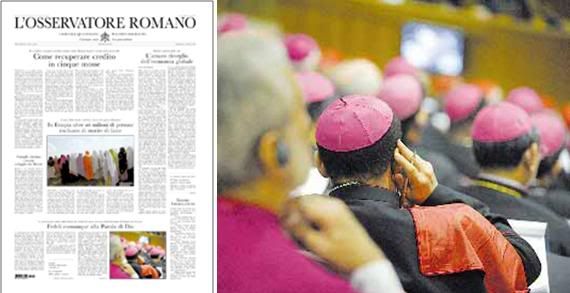 No papal stories in this issue except for a calendar item on the canonization rites today. Main stories are:
No papal stories in this issue except for a calendar item on the canonization rites today. Main stories are:
the G7 nations agree on a 5-point plan to recover global credit, and an editorial commentary on the bitter
awakening of the global economy. In Ethiopia, at least six million risk death from famine due to drought
and food scarcity; in Iraq, more Christian families forced to flee Mosul; and the Bishops' Synod considers
anti-Christian persecutions in India, Iraq and the Sudan.
THE POPE'S DAY
The Holy Father canonized four new saints at a Mass in St. Peter's Square this morning
and led the noontime Angelus afterwards.
[Modificato da TERESA BENEDETTA 12/10/2008 14:53] |
 12/10/2008 13:32 12/10/2008 13:32 |
|
| | | OFFLINE | | Post: 15.305 | Registrato il: 28/08/2005
| Utente Gold | |
|
 THE CHURCH HAS FOUR NEW SAINTS
THE CHURCH HAS FOUR NEW SAINTS
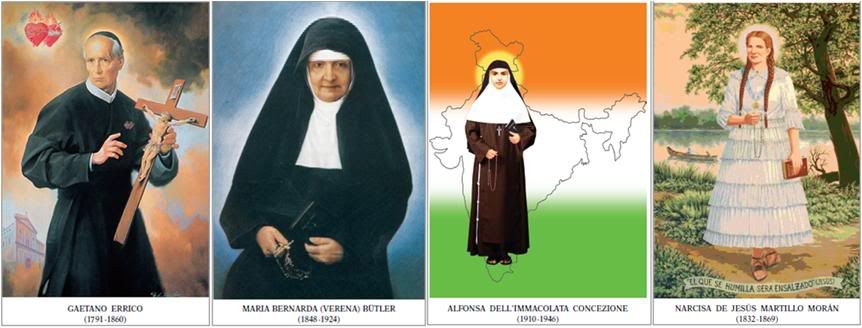
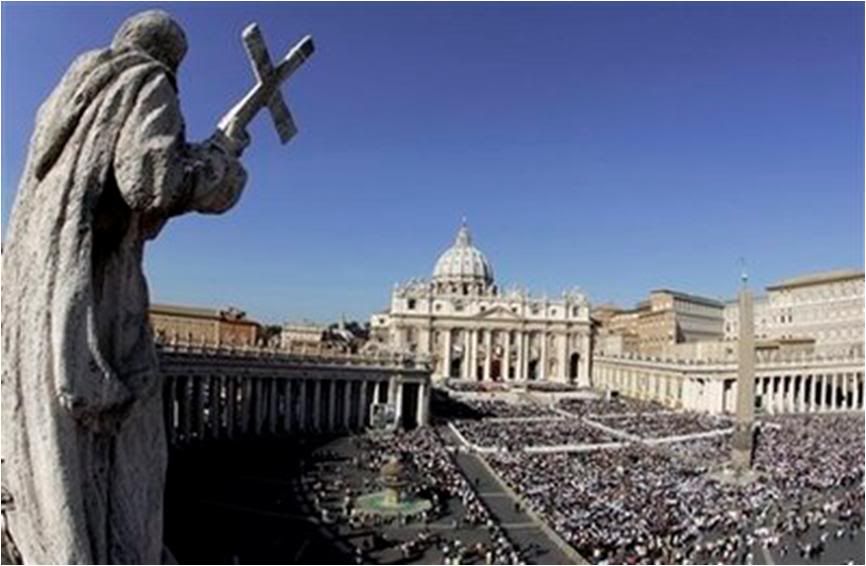
 Pope creates 4 new saints,
Pope creates 4 new saints,
including Indian woman
By FRANCES D'EMILIO

VATICAN CITY, Oct. 12 (AP) - Pope Benedict XVI on Sunday gave the Roman Catholic church four new saints, including an Indian woman whose canonization is seen as a morale boost to Christians in India who have suffered Hindu violence.
Thousands of faithful from the homelands of the new saints, including a delegation from India, where Catholics are a tiny minority, turned out for the ceremony in St. Peter's Square.
The honor for Sister Alphonsa of the Immaculate Conception, the first Indian woman to become a saint, comes as Christians increasingly have been the object of attacks from Hindu mobs in eastern and southern India.
Benedict's predecessor, John Paul II, had beatified Alphonsa during a pilgrimage to India in 1986. Beatification is the last formal step before sainthood, the Church's highest honor for its faithful. Alphonsa, a nun from southern India, was 35 when she died in 1946.
The other new saints are: Gaetano Errico, a Neapolitan priest who founded a missionary order in the 19th century; Sister Maria Bernarda, born Verena Buetler in Switzerland in 1848, who worked as a nun in Ecuador and Colombia; and Narcisa de Jesus Martillo Moran, a 19th century laywoman from Ecuador who helped the sick and the poor.
"May their examples give us encouragement, their teachings give us direction and comfort," Benedict said in his homily.
When Benedict read the Latin words proclaiming all four saints, many in the crowd in the square waved flags from the homelands of the newly honored.
An aide held a white umbrella over the Pope to shield him from a hot sun as he sat in a chair on the steps of St. Peter's Basilica to receive Mass gifts during the ceremony.
Many people associate Mother Teresa, a Nobel Peace Prize-winning nun, with India. The ethnic Albanian came to India as a young woman to work with India's most desperately poor. She died in 1997 and John Paul beatified her in 2003.
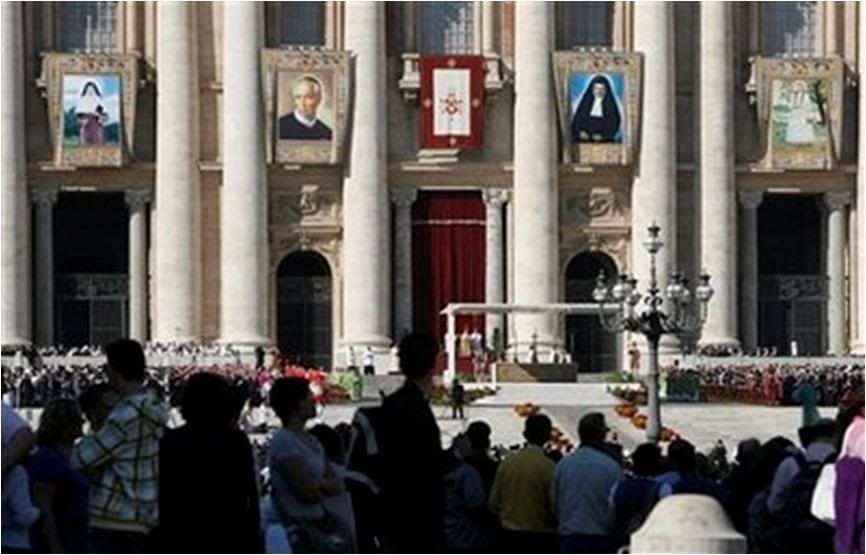
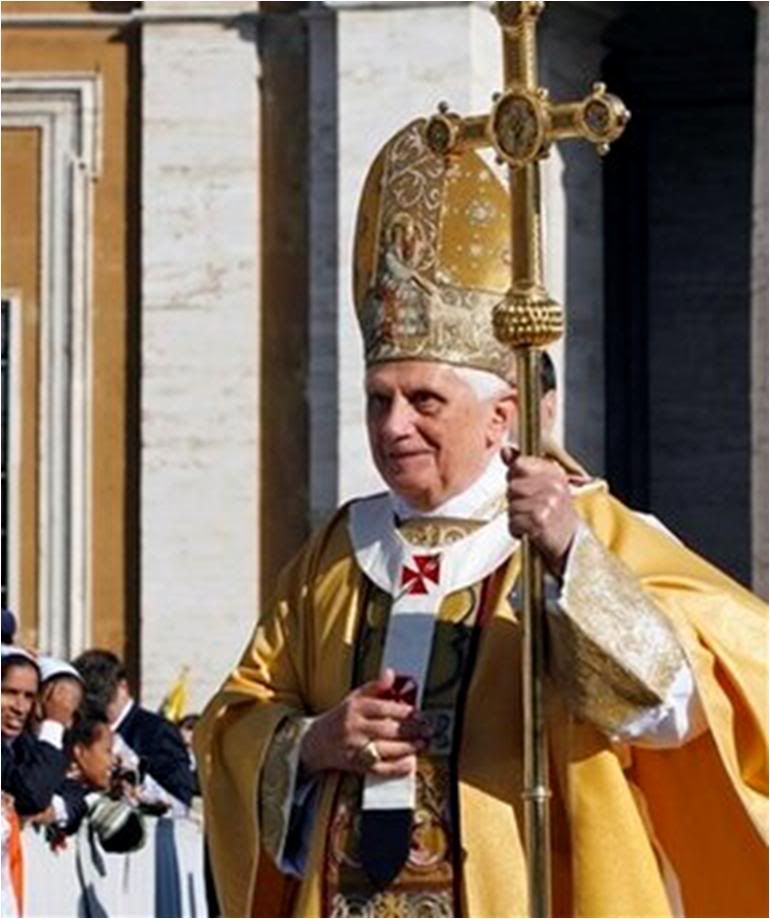
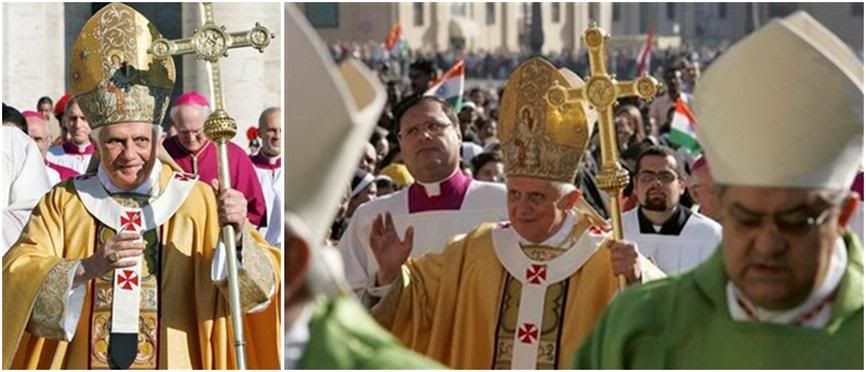
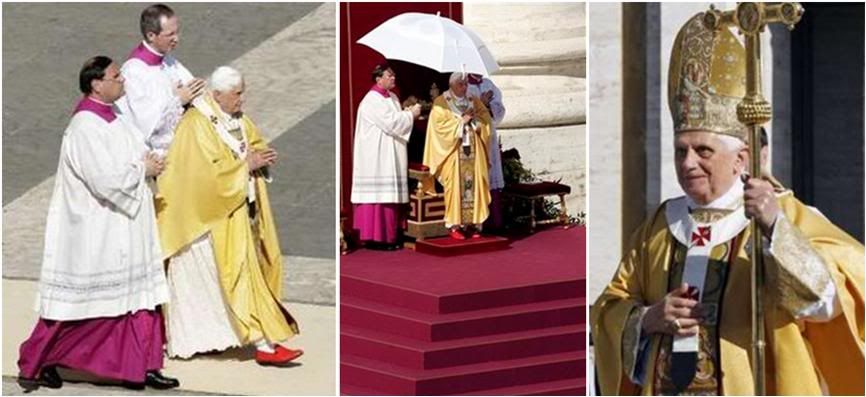
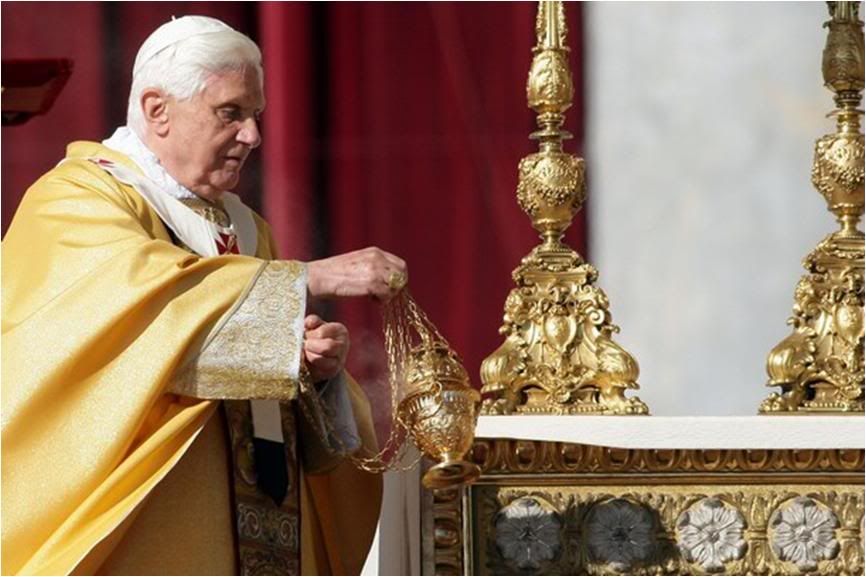
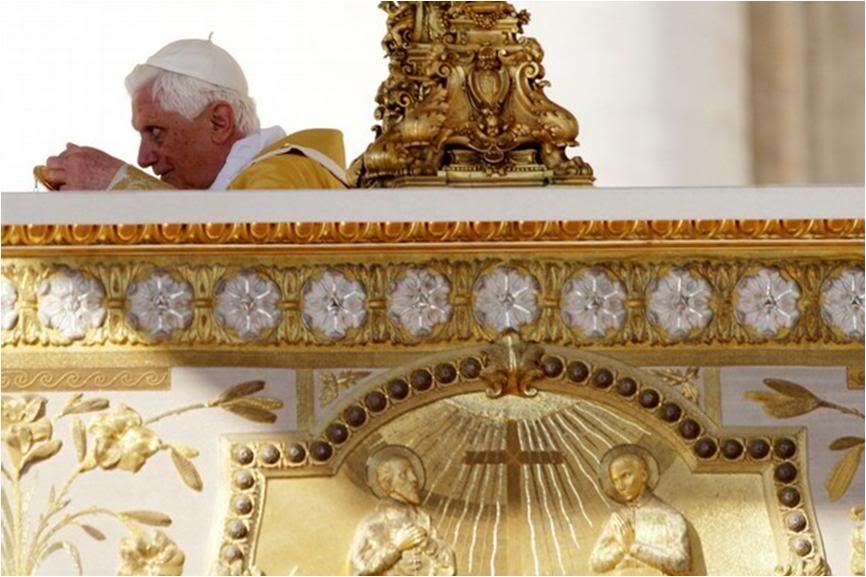 THE POPE'S SPECIAL APPEALS AT ANGELUS
THE POPE'S SPECIAL APPEALS AT ANGELUS
The Holy Father's Angelus messages today, delivered after the Canonization Mass, were specifically addressed to the pilgrims and nations associated with the four new saints, but at the end, he called on all the faithful, in this month of the Holy Rosary, to pray the Rosary as a daily means of union with Jesus and as an instrument to interceed for the needs of the Church and the Pope's intentions.
"In this regard, I invite you all to pray for reconciliation and peace in some situations which have caused alarm and great sufferings. I think of the people of Northern Kivu in the Democratic Republic of the Congo, and the violences against Christians in Iraq and India, whom I remember daily to the Lord.
"Let us invoke the protection of Mary, Queen of Saints, for these, as well as for the work of the Bishops' Synod meeting these days at the Vatican."
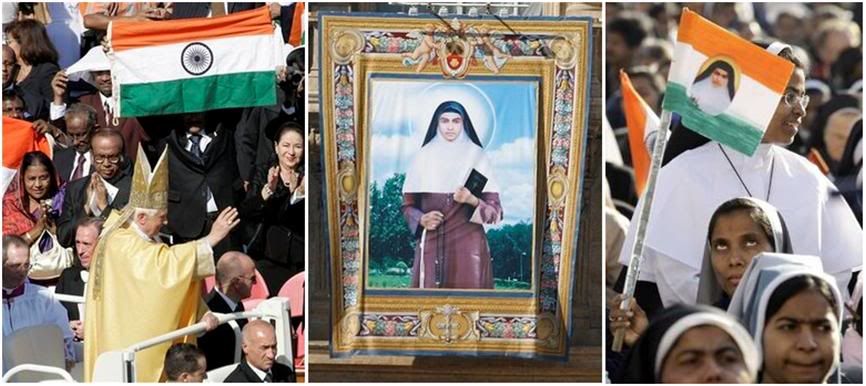
A saint for India: An Apcom report says that several bishops, 700 priests, 200 religious and 4000 lay faithful came from India for Sister Alphonsa's canonization.
Pope condemns violence
against Christians in Iraq, India

VATICAN CITY (AFP) - Pope Benedict XVI condemned on Sunday violence perpetrated against Christians in India and Iraq.
"I invite you to pray for peace and reconciliation as situations cause concern and great suffering.... I think of violence against Christians in Iraq and India," he said after a ceremony in which he canonised India's first woman saint.
The Pontiff addressed Indians who made the trip to Vatican City for the canonisation of Sister Alfonsa, who died in 1946 aged 36.
India's Christian minority, making up little more than two percent of the population, has felt particularly threatened in recent months.
Attacks by Hindu extremists on Christians in the eastern Indian state of Orissa have left 35 people dead since August
"As the Christian faithful of India give thanks to God for their first native daughter to be presented for public veneration, I wish to assure them of my prayers during this difficult time," Pope Benedict said.
"I urge the perpetrators of violence to renounce these acts and join with their brothers and sisters to work together in building a civilization of love," he said.
In Iraq, the government said it dispatched nearly 1,000 police to the northern city of Mosul on Sunday to protect Christians fleeing the worst violence perpetrated against them in five years.
Nearly 1,000 Christian families have fled homes in the city since Friday, taking shelter on the northern and eastern fringes of Nineveh province after at least 11 Christians died in a spate of attacks in recent weeks.
At least three homes of Christians were blown up by unidentified attackers on Saturday in the Sukkar district of Mosul, which is regarded by US and Iraqi security forces of one of the last urban bastions of Al-Qaeda in Iraq.
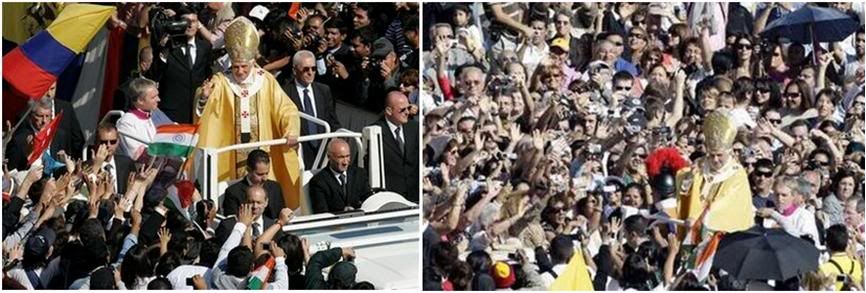
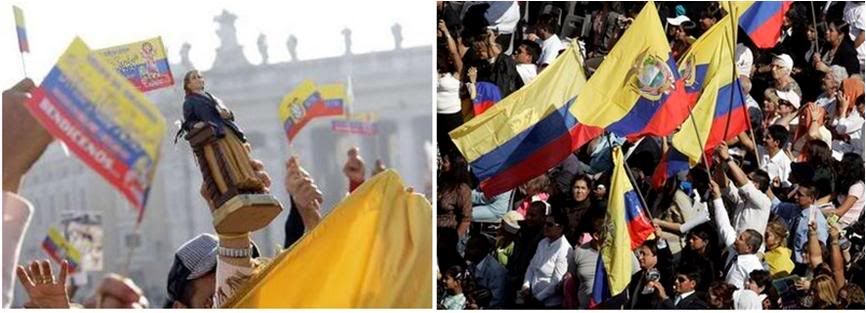
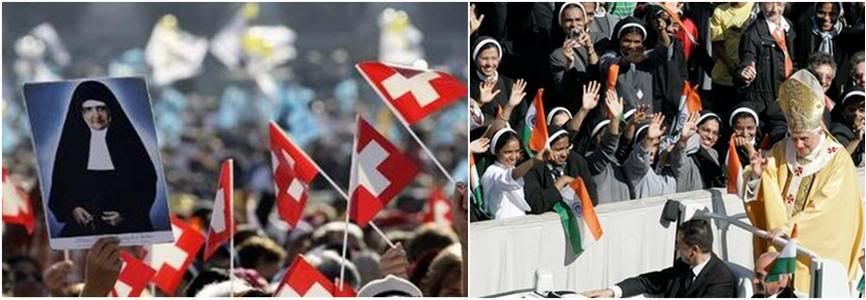
In New Delhi, posters on St. Alphonsa's canonization:
 Stories on St. Alphonsa' canonication from the Indian angle have been posted
Stories on St. Alphonsa' canonication from the Indian angle have been posted
in THE SAINTS,,, thread.
[Modificato da TERESA BENEDETTA 13/10/2008 01:13] |
 12/10/2008 16:40 12/10/2008 16:40 |
|
| | | OFFLINE | | Post: 15.307 | Registrato il: 28/08/2005
| Utente Gold | |
|
HOMILY AT CANONIZATION MASS, 10/12/08
Here is a translation of the Holy Father's homily today, which he delivered in four languages, starting and ending in Italian.
Once again, thanks to Caterina for her prompt and beautiful video-capture montage of the Mass.
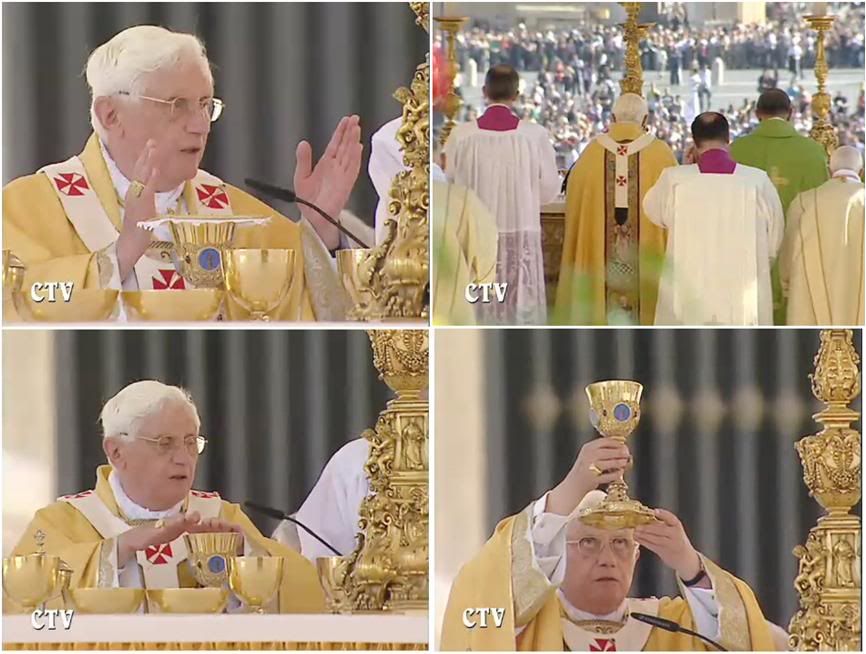
Dear brothers and sisters,
Four new saints are offered today for the veneration of the universal Church: Gaetano Errico, Maria Bernarda Bütler, Alfonsa of the Immaculate Conception, and Narcisa of Jesus (Martillo Morán).
The Liturgy presents us with the Gospel image of the guests invited to take part at a banquet dressed in wedding clothes. We find the image of the banquet even in the first Reading and in other pages of the Bible. It is a joyous image because the banquet is a wedding feast, the Alliance of love between God and his People.
Towards this alliance, the prophets of the Old Testament constantly oriented Israel's expectations. In an era marked by trials of every kind, when difficulties threatened to discourage the chosen people, the prophet Isaiah raised a reassuring voice: "On this mountain the LORD of hosts will provide for all peoples a feast of rich food and choice wines, juicy, rich food and pure, choice wines" (25,6).
God will put an end to the sorrow and shame of his people, who would finally be able to live happily in communion with him. God never abandons his people - that is why the prophet invites us to rejoice: "Behold our God, to whom we looked to save us! This is the LORD for whom we looked; let us rejoice and be glad that he has saved us!" (v 8).
If the first Reading exalts the faithfulness of God to his promise, the Gospel with the parable of the wedding banquet makes us reflect on the human response.
Some who had been invited first refused the invitation because they were drawn by other interests; others even scorned the invitation of the king, which provoked a punishment not only upon them but on the whole city.
But the king was not discouraged and sent his servants to find other guests to fill the banquet hall. Thus, the refusal by those first invited resulted in the extension of the invitation to everyone, with special favor for the poor and the disinherited.
This is what happened with the Paschal mystery: the excessive power of evil defeated by the omnipotence of God's love. The risen Lord could henceforth invite everyone to the banquet of paschal joy, providing the wedding garments himself to the guests, a symbol of the free gift of his sanctifying grace.
But to God's generosity, man should respond with free adherence. This is the generous way that was taken by the saints we venerate today. In baptism, they received the wedding garment of divine grace - they kept it pure and and made them splendid in the course of their lives through the Sacraments.
Now, they are taking part in the nuptial banquet in heaven. That celestial banquet is a foretaste of the banquet of the Eucharist, to which the Lord invites us everyday and in which we should take part with the wedding garment of his grace.
If we happen to soil or even tear up these garments through sin, the goodness of God does not reject us nor abandon us to our own destiny, but offers us, in the sacrament of Reconciliation, the chance to restore integrity to the wedding garment that is needed for the feast.
The ministry of Reconciliation is thus one that is always relevant. And it was to this that the priest Gaetano Errico, founder of the Congregation of the Missionaries of the Sacred Hearts of Jesus and Mary, dedicated himself with diligence, assiduousness and patience, without sparing himself.
He thus belongs among extraordinary figures of priests who tirelessly made the confessional the place for dispensing the mercy of God, helping men to find themselves again, to fight against sin and to progress in their spiritual life.
The street and the confessional were the chosen venues for this new saint's pastoral activity. The streets allowed him to meet people to whom he addressed his customary invitation: "God loves you. When can we see each other?" And in the confessional, he made it possible for them to encounter the mercy of the heavenly Father.
How many wounded souls he healed in that way! How many people he brought to reconciling with God through the Sacrament of forgiveness! Thus St. Gaetano Errico became an expert in the 'science' of forgiveness, and occupied himself in teaching it to his missionaries, whom he admonished: "God, who does not wish the death of sinners, is always more merciful than his ministers. Therefore be merciful as much as you can be so that you may find mercy with God."
He eulogized the next saint in German:
Maria Bernarda Bütler, who was born in Auw, in the Swiss canton of Aargau, had an early experience of the Lord's deep love, and as she said, "it is almost impossible to explain this to others who have not felt it themselves".
This love led Verena Bütler to enter the Capuchin monastery of Mariahilf (Mary's Help) in Altstätten, where at 21, she made her vows. At 40, she began her missionary vocation and headed to Ecuador, then to Colombia. Because of her life and dedication to her fellowmen, my venerated predecessor John Paul II raised her as a Blessed One to the honor of the altar on October 29, 1995.
He continued in Spanish:
Mother Maria Bernarda, a figure who is much remembered and particularly loved in Colombia, understood very well that the feast the Lord has prepared for all peoples is represented very specially in the Eucharist. In it, Christ himself receives us as friends and gives himself to us at the meal of Bread and the Word, entering into intimate communion with each of us.
This is the source and the pillar of spirituality of this new saint, and of her missionary impulse which led her to leave her native Switzerland to open new missionary horizons in Ecuador and Colombia. In the serious adversities that she had to overcome, including exile, she carried in her heart the exclamation in the Psalm we heard today: "Even when I walk through a dark valley, I fear no harm for you are at my side" (Ps 22[23],4).
In this way, obedient to the Word of God in the example of Mary, she did as those servants which the Gospel we heard speaks of: she went where she could to proclaim that the Lord invites everyone to his feast. So she made others take part in the love of God to which she dedicated her life with happiness and joy.
He spoke next in English:
"He will swallow up death for ever, and the Lord God will wipe away tears from all faces" (Is 25:8). These words of the prophet Isaiah contain the promise which sustained Alphonsa of the Immaculate Conception through a life of extreme physical and spiritual suffering.
This exceptional woman, who today is offered to the people of India as their first canonized saint, was convinced that her cross was the very means of reaching the heavenly banquet prepared for her by the Father.
By accepting the invitation to the wedding feast, and by adorning herself with the garment of God’s grace through prayer and penance, she conformed her life to Christ’s and now delights in the "rich fare and choice wines" of the heavenly kingdom (cf. Is 25:6).
She wrote, "I consider a day without suffering as a day lost". May we imitate her in shouldering our own crosses so as to join her one day in Paradise.
He spoke again in Spanish about the fourth new saint:
The young Ecuadorian laywoman Narcisa de Jesús Martillo Morán offers us a perfect example of the prompt and generous response to the invitation the Lord makes to participate in his love. From an early age, upon receiving the Sacrament of Confirmation, she felt in her heart the call to live a life of sanctity and dedication to God.
In order to follow obediently the action of the Holy Spirit in her soul, she always sought the counsel and guidance of good and knowledgeable priests, considering spiritual direction as one of the most effective ways to achieve holiness.
St. Narcisa de Jesus shows us a way of perfection that is attainable by all the faithful. In spite of the abundant and extraordinary graces she received, she lived her life with great simplicity, dedicated to her work as a seamstress and her apostolate as a catechist.
In her passionate love for Jesus, which led her to follow a path of intense prayer and mortification, and of identifying herself ever more with the mystery of the Cross, she offers us an attractive testimony and a perfect example of a life totally dedicated to God and our fellowmen.
He concluded the homily in Italian:
Dear brothers and sisters, let is give thanks to the Lord for the gift of sanctity which shines forth today with singular beauty in the Church. Jesus invites each of us to follow him, as these saints did, in the way of the Cross, in order to have afterwards the legacy of eternal life which he gave to us in dying.
May their examples be an encouragement, may their teachings orient and comfort us, may their intercession sustain us in our daily efforts, so that we too may one day share with them and all the saints the joy of the eternal banquet in the heavenly Jerusalem.
May this grace be obtained for us above all by Mary, the Queen of saints, whom we venerate with special devotion in this month of October. Amen.
 THE POPE'S GREETINGS BEFORE THE ANGELUS
THE POPE'S GREETINGS BEFORE THE ANGELUS
Before we conclude this celebration with the recital of the Angelus, I wish to address my greetings to the pilgrims who have come from various places to pay homage to our new saints.
In English, he said:
I cordially greet the English-speaking pilgrims, in particular the Official Delegation from India, and all those who have come to celebrate the canonization of Saint Alphonsa of the Immaculate Conception.
Her heroic virtues of patience, fortitude and perseverance in the midst of deep suffering remind us that God always provides the strength we need to overcome every trial.
As the Christian faithful of India give thanks to God for their first native daughter to be presented for public veneration, I wish to assure them of my prayers during this difficult time.
Commending to the providential care of Almighty God those who strive for peace and reconciliation, I urge the perpetrators of violence to renounce these acts and join with their brothers and sisters to work together in building a civilization of love. God bless you all!
In German, he said:
I joyously welcome all the German-speaking faithful, especially the official delegation and the numerous pilgrims from Switzerland, as well as the Franciscan Missionary Sisters of Mariahilf.
St. Maria Bernarda dedicated her entire life to the Lord. She became an instrument of the love of God, whom she announced to the ends of the earth.
In her example we, too, wish to act in order to bring the God of love and hope to men. To this end, may the Lord grant you the fullness of his graces.
In Spanish, he said:
I address a warm greeting to the pilgrims who came to Rome to participate in the joyous celebration of proclaiming our new saints, especially to the Archbishops and Bishops who accopmany them, to the Sister Missionaries of Mary Help of Christians, and to the delegations and other authorities from Colombia and Ecuador who are here to represent those lands that are so fertile in the fruits of sanctity.
May the new saints intercede for all their fellow citizens of today so that, following the saints' examples of consistency in the faith and charity towards their brothers, they may constantly bear witness to the love of Christ for all men, thus bringing new vigor to the Christian roots of their countries, and illuminating the construction of a soiety that is more just and fraternally solid, inspired by the values of the Gospel. Many thanks.
He next spoke in French:
I heartily greet the French-speaking pilgrims. Today, following the call of the Lord and the example of the saints who have just been canonized, we are led, at the crossroads, to be daring witnesses to the Word of God in order to invite to the wedding banquet of the Gospel all those whom we meet.
May our prayers go with the General Assembly of the Bishops' Synod during the duration of their work. With my Apostolic Blessing...
In Polish, he said:
Among the participants at these solemn canonization rites, I greet the pilgrims from Poland. Your country today celebrates the day dedicated to the memory of my beloved predecessor, John Paul II. I bless every intiative that commemorates his figure. In prayer, I entrust you all to God.
He concluded in Italian:
Finally, my heartfelt greeting to Italian-speaking pilgrims, especially the spiritual sons of St. Gaetano Errico and the faithful coming from Naples and Campania.
Dear friends, in the lives of the saints, one always finds the strong spiritual presence of the Virgin Mary. I am happy to note, in this month of October, their attachment to praying the Rosary as a means of daily union with Jesus, as a source of inspriation and comfort, and as an instrument of intercession for the needs of the Church according to the Pope's intentions.
In this regard, I invite you all to pray for reconciliation and peace in some situations which have caused alarm and great sufferings. I think of the people of Northern Kivu in the Democratic Republic of the Congo, and the violences against Christians in Iraq and India, whom I remember daily to the Lord.
Let us invoke the protection of Mary, Queen of Saints, for these, as well as for the work of the Bishops' Synod meeting these days at the Vatican.
[Modificato da TERESA BENEDETTA 12/10/2008 17:47] |
 12/10/2008 19:01 12/10/2008 19:01 |
|
| | | OFFLINE | | Post: 15.309 | Registrato il: 28/08/2005
| Utente Gold | |
|
 Understanding the Pope's
Understanding the Pope's
liturgical example
by ANDREA TORNIELLI
Translated from

October 12, 2008
A review of

It is not always easy to understand, in the forest of polemical statements and journalistic simplifications, Benedict XVI's real message to the Church - more through his example than in words - with respect to liturgical celebration.
Restoring the Crucifix to the center of the altar, reviving old Church vestments, and above all, the promulgation of his 2007 Motu Proprio which liberalized the use of the pre-Conciliar Mass, are at the center of debates and discussions, often polarized between two fronts and not devoid of extreme colorations.
Therefore, the publication of a new book by Fr. Nicola Bux, entitled La riforma di Benedetto XVI (Piemme, 128 pp 128, 12 euro), must be welcomed as good news. It is a not a heavy volume but it is densely rich and well documented, with a preface by Vittorio Messori.
This is a book which helps us to 'read' the liturgical actions and initiatives of the Ratzinger Pontificate, to bring out their most profound meaning, without which one might judge them to be nothing but nostalgic exterior signs, on the one hand, or payback restoration on the other.
Bux, a theologian respected by this Pope, an expert on theology and Oriental liturgies, explains that "the nature of sacred liturgy is to be the time and the place in which God meets man" - not "something constructed by us, something invented, in order to bring about a religious experience".
Rather, it is "singing with the choir of creation and entering into cosmic reality itself".
Losing sight of this profound meaning deformed the post-conciliar liturgical movement, "on the part of both those who consider that novelty is always best, and those who retain the old as the best for every occasion".
The decision of the Pope to restore 'full citizenship' to the older form of the Roman rite - while explaining that the two Missals, ordinary and extraordinary, do not belong to different rites - "is an answer to those, traditionalists and innovators alike, who declared the old Roman rite dead with the (post-conciliar) liturgical reform, and the birth of a new one in complete discontinuity, as a true and proper rupture."
Bux recalls that the Pope, in the letter sent to all bishops to accompany the Motu Proprio, suggests (and does not oblige) that those who celebrate the Mass using the older Missal also celebrate it with the new, so "consequently, avoids delegitimizing its use".
If only because it would be paradoxical if the Mass which celebrates the Eucharist - sacrament of unity and peace - "ends up becoming a sign of division and discord". [Which it came to be, after 1969!]
In this respect, Fr. Bux observes that "liturgy as a battle standard has not been used only by traditionalist groups to affirm their Catholic fundamentalism but also by not a few progressivists to proclaim a Protestant-style autonomy and a protest against globalization (note the flags of peace and 'no to globalization' that are placed beside many altars)".
In short, a 'reform of the reform' is necessary, which, unlike the post-conciliar reform, comes from the bottom, and is not imposed by liturgical 'experts', "because if, as they claim, the old liturgy was an 'encrusted fresco', the new liturgy risks losing the fresco altogether because of the aggressive technique used to make it new".
"Liturgical reform," he writes, "has not been perfected and done with. There is need for corrections and integration, but proceeding differently from the post-conciliar manner - not imposing obligations except those that are necessary, illustrating possibilities and promoting debate".
The ultimate purpose of liturgy is "an encounter with mystery, the discovery of a new sensibility, an adequate space for the sacred, for silence, for listening" - while avoiding that liturgy is transformed, as has happened often, unfortunately, into 'an exhibition by actors' and mere 'pronouncement of words'.
With this book, which keeps to the essentials and is truly important, Bux proposes to "help understand liturgy and to celebrate it worthily as the possibility of encounter with the reality of God and a source of morality for man, since its degradation is a symbol of spiritual emptiness; to indicate the way to restore the spirit of liturgy in the sign of the one, holy, catholic and apostolic faith; and to promote a serious debate and an educative path that follows the thought and example of the Pope, thus allowing a resumption of liturgical movement."
Tornielli adds this on his blog today:
Changes at 'Divine Worship'
Translated from

In the Sunday cultural section on books of Il Giornale today, I have a review of the new book by Fr. Nicola Bux, the theologian from Bari, who has the respect of Pope Benedict XVI, and who is a profound connoisseur of the Orthodox world.
The book will be on sale starting Tuesday. It is very interesting in order to understand what the Pope intends by his Motu Proprio and other liturgical modifications in its most authentic meaning.
In the next few weeks, important changes are expected at the Congregation for Divine Worship and the Discipline of Sacraments. Nigerian Cardinal Francis Arinze is past 75 and on November 23, he will celebrate the 50th anniversary of his ordination.
Before Christmas, or at the start of the new year, he is expected to make way for Spanish Cardinal Antonio Cañizares Llovera, Archbishop of Toledo, as the new CDW Prefect.
But it appears [reported elsehwere] that the CDW secretary, Malcom Ranjith Patabendige Don of Sri Lanka, will also be leaving to become the Archbishop of Colombo, his nation's capital.
It is usually difficult and hardly done to change the two top men of a congregation at the same time, so it is likely that if the speculations are confirmed, there will be a few months between the new nominations.
* * * * * * * * * * * * * * * * * * * * * * * * * * * * * * * * * * * * * * * * * * * * * * * * * * * * * * * * * * * * *
Cardinal Canizares, who worked for a time with Cardinal Ratzinger at the CDF, is an eminent theologian in his own right, for which he has been called the 'junior Ratzinger'. It is very appropriate that a theologian with the Pope's confidence heads CDW, because liturgy is the formal, ritual expression of theology.
Speaking of speculation, here's a new one reported by Damian Thompson, editor of the UK's Catholic Herald, on his Daily Telegraph blog:
A rumour from Rome:
Abbot Edmund Power of St. Paul's Basilica
as next Archbishop of Westminster?
by Damian Thompson
Holy Smoke blog

Oct 10, 2008
My mobile buzzes with a text message from Rome. A well-connected priest writes: "The rumour is that Abbot Edmund Power at St Paul's Outside the Walls will be the next Cormac, for what that's worth."
Rumours from Rome are usually worth nothing. The reason I pass it on is that only yesterday a foreign ambassador to the Holy See also told me that Abbot Power, 55, an English Benedictine in charge of one of Rome greatest churches, is on the short list to succeed Cardinal Murphy-O'Connor as Archbishop of Westminster.
Well, we could do worse. A lot worse. Abbot Edmund was one of Pope Benedict's first appointments, and it's a big job: St Paul's is Rome's second largest basilica, the traditional burial place of the apostle himself.
"He's like a classic medieval monk," says a source. How refreshing, compared to the classic jargon-spouting middle-managers who currently run the Church in England and Wales.
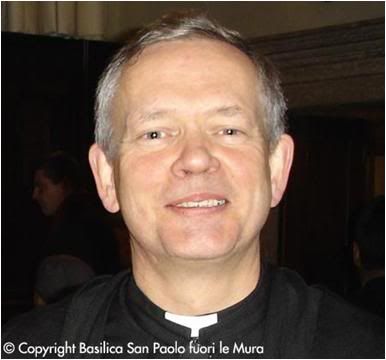
Abbot Power, former headmaster of Douai and Prior of the Benedictine University of St Anselm's in Rome, is bright. Judge for yourself: this account of his visit to India displays a lively pen and a vivid imagination. ("In one scruffy square stood a flaking statue of George V, king and emperor, gazing blankly towards bulging-bellied, many-armed Hindu deities in gaudy colours, hanging acrobatically on the walls of a small temple.")
But I'm not going to get worked up, because it's a rumour. And it's not the only one doing the rounds in Rome. The other is that Pope Benedict, dismayed by the mediocrity of the leading candidates, is going to set back the Westminster appointment by several months - and that change, when it comes, will involve several dioceses. That sounds encouraging...
[Modificato da TERESA BENEDETTA 13/10/2008 00:59] |
 13/10/2008 13:49 13/10/2008 13:49 |
|
| | | OFFLINE | | Post: 15.316 | Registrato il: 28/08/2005
| Utente Gold | |
|

No OR today.
THE POPE'S DAY
No schedule has been posted for the Holy Father today.
It is the seventh working day of the Synod assembly.
He has attended most of the congregations so far.
It was previously announced that he will be attending
a concert of the Vienna Philharmonic Orchestra
at the Basilica of St. Paul outside the Walls this afternoon.
The program is Bruckner's Sixth Symphony. The concert is part
of the VII International Festival of Sacred Music and Art in Rome.
The Vatican has released the official program
for the Holy Father's visit to Pompeii next Sunday.
Just to note: The Holy Father's appeals on India at the Angelus
after the canonization rites yesterday,
has at least resulted in attention in the Italian MSM
to the anti-Christian violence there,
after having largely ignored the news,
[Modificato da TERESA BENEDETTA 13/10/2008 15:07] |
 13/10/2008 14:00 13/10/2008 14:00 |
|
| | | OFFLINE | | Post: 15.317 | Registrato il: 28/08/2005
| Utente Gold | |
|

PASTORAL VISIT
OF HIS HOLINESS, BENEDICT XVI
TO THE SHRINE OF THE HOLY ROSARY
POMPEII, October 19, 2008
PROGRAM
Sunday, Oct. 19, 2008
ROME
09.00 Depart from the Vatican heliport for Pompeii.
POMPEII
10.00 Arrive at tme Meeting Area of the Pontifical Shrine of the
10.30 EUCHARISTIC CELEBRATION, Shrine Piazza
- Homily by the Holy Father.
- 'Supplica' (Traditional invocation to the Virgin of the Rosary)
- Offering the Golden Rose to Our Lady of Pompeii
- Angelus, with words from the Holy Dahter.
13.00 Lunch with the bishops of Campania region
Palace of the Pontifical Legation in Pompeii
17.00 RECITAL OF THE HOLY ROSARY
Pontifical Shrine of the Holy Rosary.
- Meditation by the Holy Father.
18.00 Depart by helicopter for the Vatican.
ROME
19.00 Arrival at the Vatican.
Pope to present Golden Rose
to Our Lady of Pompeii

VATICAN CITY, OCT. 13, 2008 (Zenit.org).- Benedict XVI will give a golden rose to Our Lady of Pompeii during a visit to her shrine scheduled for Sunday.
According to the program released today by the Holy See, the Pope will leave the Vatican by helicopter and arrive in Pompeii to celebrate Mass in the plaza outside the shrine.
Then, the Holy Father will offer a prayer to the Virgin and present her with a Golden Rose. He will then pray the midday Angelus.
His schedule for the one-day visit includes lunch with the bishops of the region, including Cardinal Crescenzio Sepe, archbishop of Naples, who has just returned from a pilgrimage to Moscow, where he was invited by Orthodox Patriarch Alexy II.
Afterward, the Bishop of Rome will return to the plaza outside the shrine to pray the rosary and then will return to the Vatican by helicopter.
According to Archbishop Carlo Liberati, prelate of Pompeii, the Pope is expected to "entrust to the intercession of the Mother of the Lord the reflections and conclusions of the 12th Ordinary General Assembly of the Synod of Bishops, which is under way in Rome and focused on the word of God in the life and mission of the Church."
The Pompeii shrine was built in 1876 by Blessed Bartolo Longo, a promoter of devotion to the rosary. The shrine has an image of Our Lady to which many miracles and healings have been attributed.
Pope John Paul II made the most recent papal visit to the shrine, journeying there in 2003 to mark the 125th anniversary of the church's dedication.
[Modificato da TERESA BENEDETTA 14/10/2008 02:03] |
 13/10/2008 14:53 13/10/2008 14:53 |
|
| | | OFFLINE | | Post: 15.318 | Registrato il: 28/08/2005
| Utente Gold | |
|
 Pope Benedict defrocks Florence priest
Pope Benedict defrocks Florence priest
found guilty of sex offenses
and abuse of the confessional
by Mauro Bonciani
Translated from

Oct. 13, 2008
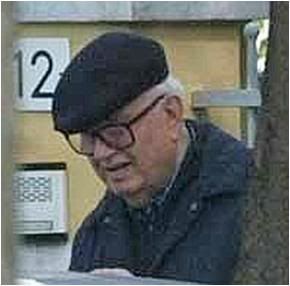
"The canonical process has been concluded on Fr. Lelio Cantini, who was involved in painful and scandalous incidents".
This was how Cardinal Ennio Antonelli, who was Archbishop of Florence until he was named President of the Pontifical Council for the Family this summer, announced the Holy Father's sentence on the priest: reduction to lay status, with obligatory 'house arrest' ['dimora vigilata' - literally, staying home under watch], prayer and penitence, and risking excommunication in case of disobedience.
The Holy Father's sentence precedes the formal installation of the new Archbishop of Florence, Mons. Giuseppe Betori, on Oct. 26, and closes an episode that shook the Church of Florence.
After denunciations made by some victims in April 2007, civilian authorities formally opened criminal investigations. Earlier, in January 2007, after diocesan inquiry into charges presented to the Archdiocese, Cardinal Antonelli had condemned Fr. Cantini for 'sexual abuses, false mysticism, and abuse of the confessional' from 1973-1987, forbidding him to perform confessions and other Sacraments and from saying Mass in public.
Since December 2008, don Cantini, now 85, has been confined at an ecclesiastical home for the aged for health reasons.
After new charges were presented to civil authorities in April 2007, Cardinal Antonelli ordered additional investigation and sent the results in July to the Congregation for the Doctrine of the Faith.
On the basis of the dossier and its own investigations, the CDF decided that "for many years, Fr. Lelio Cantini committed the crime of multiple aggravated abuse of minors, solicitation of sexual favors from many persons at the confessional, and the abuse of ecclesiastical power in the formation of consciences".
Consequently the Pope last September 18 decreed "a perpetual expiatory penalty of reduction to lay status, with a release from his priestly obligations, and an obligation to stay under watch in a place to be determined by the Archdiocese of Florence, in a spirit of prayer and penitence, under pain of excommunication in case of disobedience."
The decree was sent to don Cantini on Saturday.
"The Church of Florence, which was severely tried during this sad episode," wrote Cardinal Antonelli in a statement, "will hopefully take from this, through the grace of the Lord, reasons for more faithful, generous and courageous testimony to Christ our Savior."
"In particular," he concludes, "this assures our human and spiritual closeness to the victims of the abuses, who have suffered much, so that we may be able to make up positively for the evil they underwent in the spirit of the faith."
Don Paolo Milloschi, who succeeded Fr. Cantini as parish priest of Regina della Pace, said he was 'profoundly saddened' by the episode, but is also" very comforted by so many testimonials to the profound faith and Christian life which I see flourishing, even in the midst of pain, in our parish community."
The spokesman for Fr. Cantini's victims said he was satisfied at the verdict from the Vatican, but wants '360-degree clarity' and that "responsibility be ascertained among those who for years did not want to believe the accusations against don Cantini, which go back to 1992".
An article in La Repubblica gives a few other details of the background to the investigation by the CDF which, it says, was prompted by the direct complaint of the victims to the CDF, as they thought the administrative decision of the Archdiocese had been too 'light'.
P.S. A later newspaper account says Cardinal Antonelli himself personally delivered the verdict to don Cantini, at the Convitta Ecclesiastica, a home for aged priests run by the Archdiocese of Florence where the priest had been staying.
After the cardinal read the Pope's sentence to him, the report says, Cantini made no comment except to utter a weak 'Forgive me', then proceeded to pack his belongings and docilely followed Cardinal Antonelli who brought him to another unnamed institution of the archdiocese of Florence, where he will live out his remaining days.
The report notes that Cantini has never commented publicly on the accusations, of which the CDF investigated at least 50 cases.
Our prayers go to him and his fellow misguided priests who have caused so much anguish, as we pray for all their victims, and for the great majority of priests who labor honestly and correctly, even heroically, in the vineyard of the Lord.
[Modificato da TERESA BENEDETTA 13/10/2008 20:31] |
 13/10/2008 17:10 13/10/2008 17:10 |
|
| | | OFFLINE | | Post: 15.319 | Registrato il: 28/08/2005
| Utente Gold | |
|
 This essay offers some points of reflection, even if it is based on the short-sighted erroneous premise
This essay offers some points of reflection, even if it is based on the short-sighted erroneous premise
of viewing Benedict XVI as the successor of John Paul II rather than the Successor of Peter, and even if
it offers a false choice, or rather a non-choice.
One of the pictures posted by Caterina today in the main forum thread, LE FOTO PIU BELLE,
makes an appropriate illustration.
Benedict XVI's challenge:
Prioritizing from the 'saintly' to the 'sacred'
by Luigi La Spina
Translated from

Oct. 12, 2008
An autumn night in St. Peter's Square. The air is mild, but like that other night, is agitated now and then by a sudden, angry gust of wind. Only a police car keeps watch, and the murmur of water from the two fountains muffles the few footsteps of late night passersby on the cobblestones.
The embrace of the Bernini colonnade seems too vast when one is alone in a space meant to hold crowds. And so, one keeps company with the memory of that spring evening more than three years ago - the last vigil for the old Pope.
Up above, where the lights are now out, two windows had been alight, but all eyes were on the glimmer of light coming from the next window on the third floor of the Apostolic Palace. As though to support the Pope, by the very act of looking.
Around the obelisk, where some newspaper pages are swirling now, there were candles lit and kept going by a group of Poles with their red-and-white flags. In the corners not reached by the spotlights from the Basilica, the silence that the loudspeakers asked for from time to time was broken by the sound of a guitar. Young people, come from who knows where, wanted to show that an instrument of joy could also sing the pain of an imminent end.
It is strange how feelings alone can 'telescope together' all of historical time and place one abreast of a Church which has been around for two millennia.
But three and a half years, even for believers, is a lot of time. Institutions, even those that think in terms of eternity, are made up of men who change, and who also 'change' the Church.
The longer the past is, the more it seems to change more slowly, but nevertheless, one must acknowledge changes.
Today, we have a Pope who was entrusted with the most difficult task imaginable: to protect nostalgia for John Paul II without transforming it to regret. [This is the unfortunate and very erroneous bias, which unbelievably, the writer proceeds from. A Pope does not have an obligation only to his immediate successor, but to the whole Church and its history, which includes all the Popes.]
Benedict XVI is trying to carry out this hard mission and one can now ask how is he doing. There is a new man, Cardinal Tarcisio Bertone, as Secretary of State, in effect, the prime minister of the Vatican government. [Every Pope is entitled to name his own Secretary of State!]
There is also a new head for the Italian bishops, Cardinal Angelo Bagnasco, who is also working under a difficult succession - to the 20-year 'dictatorship' of Cardinal Ruini.
One cannot look at the Italian Church today, in its structures and its problems, without starting from its head, the Pontiff. Not just for formal reasons: the Pope is Bishop of Rome and Primate of Italy. But for a more profound reason, and which does not derive from geographical circumstance nor hierarchical subordination.
To understand the changes in pontifical style, one simply has to look at the immediate and significant adjustments to the profile of the Church in Italy. It is like what happens when a newspaper changes editors, and its Page 1 soon reflects the editor's temperament and tendencies.
As in all risky itineraries, one must guard against many traps when doing a 'secular' walk through the 'sacred palaces'. There are, at least, two main dangers, apparently contradictory.
One is applying one's usual mental habits of looking at Vatican affairs from the secular 'political' point of view.
The other is dealing with the hypocrisy or the fear of so many who will talk only on condition of anonymity; or who, out of habit or to protect their position, would deny that in the Roman Curia, human vices exist, like vanity, rivalries, conflicts, and even, guerrilla warfare on both big and small scale.
It was Benedict XVI himself who, as Cardinal Ratzinger, had spoken in his famous Via Crucis of Good Friday in 2005, a severe anathema against the wrongdoings of men of the Church. Then reiterated by him, as dean of the College of Cardinals, in his equally famous homily just before the Conclave that would elect him as Pope.
If, in the words of the new editor of L'Osservatore Romano, Giovanni Maria Vian, "continuity, beyond the differences among persons, constitutes the backbone of the Catholic Church", it is clear to all that the change in the pontifical style between Papa Wojtyla and Papa Ratzinger is not only due to their personality differences.
John Paul II exercised on the Church a vigorous 'interventionist' shake-up, imposing on it a strong public presence, inviting it to accept the challenge of the modern world, and sculpting Catholic identity in today's society.
Benedict XVI is more concerned with defining the fundamentals of this identity by presenting and representing it himself.
"It is not by chance," notes a refined theologian from Turin, don Ermis Segatti, "that a Pope writes a book on Jesus".
Precisely because Christianity cannot live on stale tradition, one must turn back, not to what has become habitual faith, but to a faith regenerated by a plunge, so to speak, into its origins.
This is the purpose that unifies the two most discussed aspect of Papa Ratzinger's preaching: 'the intrinsic communicability between faith and reason', as Rector Lorenzo Ornaghi of the Catholic University of Milan wrote in a recent editorial for Vita e Pensiero, and the re-launching of that symbology which, for centuries, has accompanied the life of the Church in man's history.
Even the most convinced defenders of the Pope's selective restoration of some older practices in the liturgy are aware that this initiative has raised surprise and perplexity. [Surprise? Most observers expected it, if not something even more drastic, given his known positions for decades before becoming Pope.] Simply because it could easily be assumed as manifest proof of a conservative mentality that is closed off to modernity.
There are numerous examples, such as the liberalization of the traditional Mass in Latin and the possibility of celebrating Mass facing the Eucharist in the tabernacle, that is, 'with the priest's back to the public', and the more exterior signs like his use of the camauro, or the ferula, Pius IX's pastoral staff, or giving Communion on the tongue.
But this attitude is motivated precisely by the need to "launch a message of continuity", as Vian says, although "one must not simplistically confuse continuity with restoration."
"This Pope," says don Segatti, "is an intellectual who communicates on two levels: he speaks to those who can understand his words in order to show the lack of contradiction between reason and faith; and to others, through example, to underline a value that he considers fundamental - popular tradition."
This is a trait that remains strong in Italy, in contrast to most other European nations, and which helps the believers in our country to be strong in the face of the secularization that has become characteristic of Western societies.
The difficulty of labelling the line that Benedict XVI is imprinting on the Universal Church - and therefore, to identify it analogously in the Italian Church - is reflected in some sectors of the hierarchy and laity who consider that they represent the conciliar/Paul VI tradition, by their interest in this Pope's intellectual emphasis on recovering the reasons of the faith.
They see it as an antithesis - rather forced but understandable - to their mistrust for the militancy, political and ethical, of the Catholic model propagated by John Paul II and his standard-bearer in Italy, Cardinal Camillo Ruini. [But Benedict XVI and Cardinal Bagnasco are no less militant in behalf of Catholic values!]
It is as though that 'plunge' into the fundamentals of the faith has somehow managed to suck into its vortex all the varieties of persons who call themselves Catholics in Italy today. [Good! Then, it is off to a good start!]
The Catholic sociologist Giuseppe De Rita traces this "true change between the present Pope and his predecessor, to the substitution by Papa Ratzinger, with the help of Mons. Ravasi, of the 'sacred' in place of the 'saintly'." [With all due respect, even if the Pope did name Mons. Ravasi President of the Pontifical Council for Culture last year, and Ravasi is an intellectual in his own right, I have never read anywhere that Ravasi was an influence on Benedict in any way, nor that he is now in the forefront of what the Pope has been doing almost singlehandedly from the time he became Pope!]
In the sense that John Paul II tended towards affirming the social presence of Catholics engaged in creating a new model of public life, founded on the absolute importance of the human being. [And how is that different from what Benedict II is doing, in his own way? His great speech on human rights to the United Nations last April - which did not dwell on the usual platitudes but opened new questions - continues to be largely ignored. And in his address to the national convention of the Italian Church in 2006, he first called very strongly for 'healthy secularity' and the active involvement of Catholics in public life and the public discourse - long before Nicolas Sarkozy made headlines for advocating 'positive secularity'!]
Whereas for Benedict, what prevails is mystery, the feeling for the sacred, as a life-changing, penetrating message in the soul of the people, not only of Catholics, but even of seculars. [Then, in this [sense, the Pope is not 'replacing the saintly with the sacred', but simply emphasizing that to be saintly, one must first have a sense of the sacred. Probably another way of saying man is justified by both grace and good works - and by extension, that grace can only lead to good works, so one cannot neglect grace.]
From this interweaving of a return to the centrality of the faith, of traditionalist and popular symbology, and even of formalism when presenting this symbology in public, Benedict XVI's personality impacts on the Church hierarchy and the faithful through a particular mission - a commitment to pastoral education.
Vian, the editor who has given the Pope's newspaper a much more open and interesting character, even for laymen, says "There is an educative emergency in this country". [Strange to quote Vian, who is only quoting Benedict XVI, who has made this one of his watchwords for the Italian Church since Verona in 2006, and has repeated it on every occasion!]
This is echoed in heartfelt tones - in the light of his experience with young people - by the dean of the Salesian university, Fr. Franco Lever: "Parallel to the religious movement, it is necessary to reincarnate living according to the faith, otherwise ritual is empty. Just as there was a revolution in seminaries after the Council of Trent, we must now invest strongly in forming our priests, teachers and community leaders in order to insure correct educational formation".
There's a saying that is frequently heard across the Tiber. Like all syntheses, it clues in a lot of things but it can also raise misunderstandings. But it is worth repeating because it may help to understand the reflections on the Italian Church of the change of Popes at the start of the third millennium: "Wojtyla wanted to fill the public squares; Ratzinger wants to fill the churches".
[It does not explain anything because it is an unfortunate and very evidently erroneous statement: Can there be any Pope that would not want to 'fill the churches'? Can those who spout it not see that it is downright demeaning to John Paul II?
It is, of course, as facile and fallacious as the other terrible saying: "People flocked to John Paul II to see him; they come to Benedict XVI to hear him", which even intelligent Catholics repeat thoughtlessly. It ignores the simple fact that Catholics will flock to the Pope, any Pope, if they have a chance, for the full experience of 'seeing the Pope' - not just seeing him in person and listening to him, but absorbing something spiritual from the experience and the direct impact of the Pope's presence.]
[Modificato da TERESA BENEDETTA 14/10/2008 02:53] |
 13/10/2008 18:40 13/10/2008 18:40 |
|
| | | OFFLINE | | Post: 15.321 | Registrato il: 28/08/2005
| Utente Gold | |
|
 Here is a good example of the stories in the Italian press today about the Holy Father's appeals yesterday against anti-Christian violence.
The Pope's appeal on India and Iraq:
Here is a good example of the stories in the Italian press today about the Holy Father's appeals yesterday against anti-Christian violence.
The Pope's appeal on India and Iraq:
'Stop persecution -
let us build together
a civilization of love'
by FRANCA GIANSOLDATI
Translated from

Oct. 13, 2008
VATICAN CITY - Papa Ratzinger spoke about the new war in the Congo yesterday but most of all, about Christians who are persecuted in India and Iraq.
Their sufferings are a cause of anguish, he told the faithful yesterday who had gathered festively in St. Peter's Square for the canonization of four new saints, among them, the first female Indian saint, St. Alphonsa of the Immaculate Conception (1910-1946).
Directly addressing Hindu fundamentalists, who have been responsible for the recent wave of violence which continues to be a difficult burden on the Christian communities of India, he delivered his appeal in English:
"Commending to the providential care of Almighty God those who strive for peace and reconciliation, I urge the perpetrators of violence to renounce these acts and join with their brothers and sisters to work together in building a civilization of love."
Seated in the VIP sector at St. Peter's Square for the canonization rites yesterday, near the altar, was a delegation of Indian officials sent to Rome by New Delhi to render homage to their new saint, but most of all, as a conciliatory sign to the Holy See.
To counter the anti-Christian persecution in India, the Vatican has registred its protest in international organizations, and has been campaigning in the foreign ministries of the European nations to 'sensitize' them to the need of defending and protecting the fundamental human right to religious freedom.
The Pope also prayed for Iraq, where, according to Vatican Radio, not just 150 but more than 900 Christian families have had to flee the northern city of Mosul in the past 24 hours to seek refuge in Christian villages north and east of Mosul, which is the capital of Nineveh territory.
Benedict XVI cited the anti-Christian violence that has been evident in Iraq since 2003, and called for an end to the new spiral of anti-Christian violence.
Since September 28, at least 11 Christians have been assassinated in Mosul because of their religious affiliation. In the past few days, in the Suka quarter of the city, many homes belonging to Christians were blown up by terrorist bombs.
Priests in Baghdad have been informed by their contacts in Mosul that unknown groups have been circling Christian neighborhoods with megaphones and loudspeakers to urge them to leave the city as soon as possible or be targeted for reprisal.
But the Pope and the Church in Italy have also expressed rising concern in recent days for manifestations against black immigrants lately. Benedict referred to it during his recent visit with Italian President Giogio Napolitano.
Attacks spur concerns
about racism in italy

Italy is tolerating discrimination, xenophobia and racism as incidences of violence against black immigrants mount, Vatican leaders say.
A recent spate of attacks on immigrants has led some Italian politicians to say the country is facing a racism emergency, while Pope Benedict XVI met this month with President Giorgio Napolitano to call for church and state to work together on what the Pontiff called worrisome new signs of worsening social tensions, the New York Times reported Monday.
The papal comments came as Monsignor Agostino Marchetto, secretary of the Pontifical Council for Pastoral Care of Migrants and Itinerant Peoples, denounced discrimination, xenophobia and racism toward immigrants in Italy.
Meanwhile, anti-immigrant pressure on Prime Minister Silvio Berlusconi is coming from the conservative Northern League, the Times said. That party is calling for new controls on immigrants as part of a pending security bill, including a system wherein even legal immigrants could be deported by racking up a certain number of points on their criminal records.
"You can't say all Italians are racist, but it would also be dangerous to underestimate what's happening," Jean-Leonard Touadi, a black member of Parliament, told the newspaper.
I have posted the New York Times article that was the source of this item in the CULTURE & POLITICS thread...
as well as a good story from the Times today about the anti-Christian violence in Orissa, India, in NEWS ABOUT THE CHURCH.
[Modificato da TERESA BENEDETTA 13/10/2008 19:44] |
 13/10/2008 20:49 13/10/2008 20:49 |
|
| | | OFFLINE | | Post: 15.324 | Registrato il: 28/08/2005
| Utente Gold | |
|
 Pontiff backs Muslim-Christian meeting
Pontiff backs Muslim-Christian meeting
sponored by Focolare
By Inmaculada Álvarez

VATICAN CITY, OCT. 13, 2008 (Zenit.org).- Benedict XVI says he is hoping that a meeting between Christians and Muslims will give rise to a renewal in mutual commitments and dialogue.
The Pope said this in a telegram sent by his secretary of state, Cardinal Tarcisio Bertone, to a meeting sponsored by the Catholic lay Focolare movement.
The conference is focused on “Love and Mercy in the Bible and in the Koran." The meeting has gathered at Castel Gandolfo some 200 Muslims and Christians since last Thursday.
The telegram expressed the Holy Father's hope that the conference may "give rise to renewed cordial resolutions of fraternity and sincere commitments, in favor of mutual dialogue in respect of every human person's dignity."
The Pontiff invoked "the most high and merciful God to continue always guiding the steps of humanity on the path of justice and peace."
Cardinal Jean-Louis Tauran, president of the Pontifical Council for Inter-Religious Dialogue, addressed the conference participants on the first day, focusing on the potential for inter-religious dialogue to bring people among peoples.
The cardinal explained that inter-religious dialogue "does not attempt to establish, with a reductive and syncretistic criteria, a minimalist common base of religious truths."
Rather it "recognizes that everyone in search of God or the Absolute has the same dignity."
There is, Cardinal Tauran contended, "thanks above all to Muslims […] a return of religion to the world scene, as an essential contribution to structuring the international society of the 21st century, even more than the ideologies of the 20th century."
"The world today cannot understand itself without religions," he said. Nevertheless, precisely because of this, religions need to "not become a source of fear, something which happens, unfortunately, because of exasperated fundamentalism."
"It is a fact that today, people kill for religious motives, but it is not religion that makes war," Cardinal Tauran stated. "From here is born the need to place the message of religions at the service of a project of sanctity."
Dialogue between religions, he concluded, should be considered "almost like a pilgrimage," since "when one dialogues with a follower of another religion, it is necessary to take the attitude of one who embarks on a path with him, and takes into consideration convictions about the great questions that confront every person, which are distinct from one's own."
"It is not," the cardinal clarified, "one's own faith that has to be questioned, but rather the way of living it in daily life."
[Modificato da TERESA BENEDETTA 13/10/2008 20:50] |
 13/10/2008 23:47 13/10/2008 23:47 |
|
| | | OFFLINE | | Post: 15.329 | Registrato il: 28/08/2005
| Utente Gold | |
|
 BENEDICT XVI AT ST. PAUL'S
BENEDICT XVI AT ST. PAUL'S
FOR BRUCKNER SYMPHONY
Pope Benedict was the guest of honor of the VII International Festival of Sacred Music and Art Monday afternoon at the Basilica of St. Paul outside the Walls, for a performance of Anton Bruckner's Sixth Symphony by the Vienna Philharmonic Orchestra.
Also special guests were the participants in the current General Assembly of the Bishops Synod, who were bused earlier to the Basilica to make a pilgrimage to the tomb of St. Paul which was uncovered last year below the main altar of the Basilica.

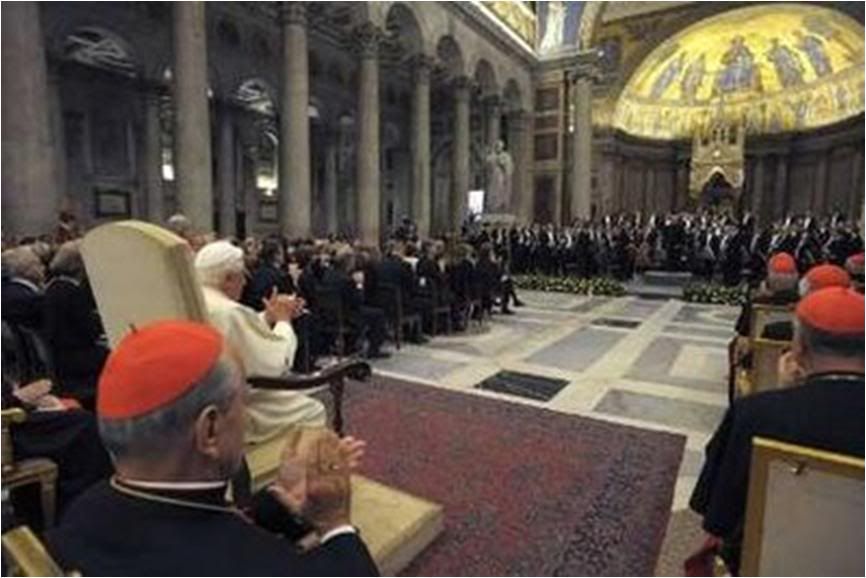
 The Church is like
The Church is like
an orchestra or a choir,
says Benedict XVI

ROME, Oct. 13 (Translated from Apcom) - The Catholic Church is like a choir or an orchestra - a single body with different members who are in accord on the same melody. This was the metaphor used by the Pope at the end of the concert held in his presence at the Roman basilica of St. Paul outside the Walls by the Vienna Philharmonic Orchestra.
Under the direction of Christoph von Eschenbach, the orchestra performer Anton Bruckner's Symphony No. 6.
"Listening to this music in the Basilica of St. Paul's is to think spontaneously of the Apostle's first letter to the Corinthians, in which he likens the Church to a human body, in which the various parts, very different from each other, are all indispensable for its proper functioning.
"Likewise, an orchestra, or a choir, made up of different instruments and voices in accord, offer music that is pleasing both to the ear as well as to the spirit," the Pope said.
The performance is part of the VII International Festival for Sacred Music and Art of the Fondazione pro Musica ed Arte Sacra, coinciding this year with the XII Ordinary General Assembly of the Bishops Synod.
After the concert, among the many guests who came to greet the Pope was Gianni Letta, the undersecretary of the Prime Minister's Office who has been representing Prime Minister Silvio Berlusconi at almost every public event attended by the Holy Father.
 Here is a translation of the Holy Father's words after the concert. He began and ended in Italian, with German in between:
Here is a translation of the Holy Father's words after the concert. He began and ended in Italian, with German in between:
BENEDICT XVI'S REMARKS
AFTER THE CONCERT
Eminent cardinals.
Venerated brothers in the Episcopate and priesthood,
dear brothers and sisters:
The concert tonight is among the various initiatives on the calendar for the special Pauline Year jubilee, and held in the evocative setting of the Basilica of St. Paul outside the Walls, where a few days ago, we solemnly inaugurated the ordinary General Assembly of the Bishops' Synod.
My greetings and heartfelt gratitude go naturally to those who promoted and organized such a high-level musical event for this beautiful evening.
First, I must thank the Fondazione Pro Musica e Arte Sacra, which has become known for its multiple initiatives. And I also greet and thank the members of the Vienna Philharmonic who have offered us a masterful performance of the Sixth Symphony of Anton Bruckner, a work permeated with religiosity and profound mysticism.
He said the following in German:
With grateful joy I greet the Vienna Philharmonic which has, today under the direction of Christoph Eschenbach, for the seventh time in the history of the International Festival of Sacred Music and Art, gifted its audience with special happiness.
Dear friends, you have succeeded once again, as always, with your professionalism and artistic knowledge, to touch the hearts of your listeners, and, in bringing them Bruckner's wonderful music, to make all the chords of human sensitivity vibrate.
With your musical talent, you are able to take your listeners away from the human towards the divine. And for this, I say to you all, 'Vergelt's Gott' ["God will reward you', a Bavarian form of saying 'Thank you'.]
He resumed in Italian:
Bruckner's sixth symphony translated the faith of the composer, who was able to transmit a religious vision of life and history in his compositions.
Anton Bruckner, drawing from the Austrian Baroque and the Schubertian tradition of popular song, brought to its extreme consequences, we might say, the Romantic process of interiorization.
Listening to this famous composition in the Basilica dedicated to St. Paul, one spontaneously thinks of a passage in the first Letter to the Corinthians, in which the Apostle, after speaking of the diversity and unity of charisms, likens the Church to the human body, which is composed of many members, very different from each other, but all indispensable for proper functioning (cfr Chap. 12).
Likewise, an orchestra, or a choir, made up of different instruments and voices in accord, offers music that is pleasing both to the ear as well as to the spirit
Dear brothers and sisters, let us meditate on this teaching, which we see confirmed in the splendid musical executionn that we just heard.
I greet you all with affection, with a special thought to the Synodal fathers and other personalities present.
Finally, a fraternal greeting to Cardinal Cordero Lanza di Montezemolo, Arch-Priest of this papal Basilica, who has once again welcomed us with such warmth.
I wish to thank him and all who work with him, for the diffefent religious and cultural manifestations programmed for the current Pauline Year.
May this Roman Basilica, which guards the mortal remains of the Apostle to the Gentiles, be a true fulcrum for liturgical, spiritual and artistic initiatives aimed at rediscovering missionary work and theological thinking.
Invoking the intercession of this illustrious saint and the maternal protection of Mary, Queen of Apostles, I impart the Apostolic Blessing from the heart to all present and to their loved ones.
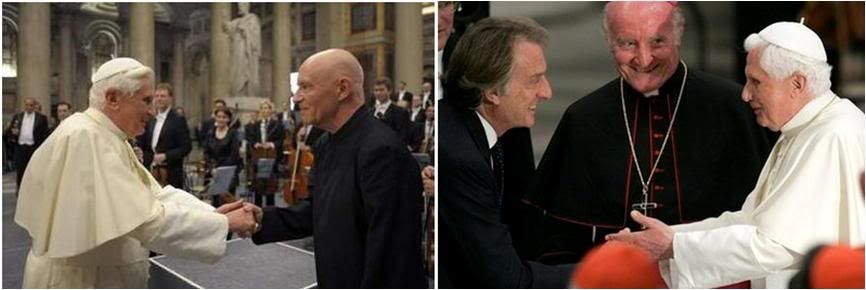 The orchestra was conducted by Christoph von Eschenbach (with the Pope, left photo). In the right photo,
The orchestra was conducted by Christoph von Eschenbach (with the Pope, left photo). In the right photo,
Pope Benedict is greeting Luca Cordero di Montezemolo, president of Fiat, and brother of Cardinal Montezemolo,
Arch-Priest of St. Paul's Basilica.
[Lella, who watched the concert on Italian independent channel Telepace - for some reason, CTV did not stream it online - says the Pope's brother, Mons. Georg Ratzinger was also at the concert.]
[Modificato da TERESA BENEDETTA 14/10/2008 21:01] |
 13/10/2008 23:51 13/10/2008 23:51 |
|
| | | OFFLINE | | Post: 15.330 | Registrato il: 28/08/2005
| Utente Gold | |
|
 Official says Vatican bank deposits
Official says Vatican bank deposits
and investments are safe
By VICTOR L. SIMPSON

ROME, Oct. 13 (AP) - A top official of the Vatican bank has offered assurances that its deposits are safe from the world financial meltdown, an Italian Catholic magazine said Monday.
Angelo Caloia said in interview released Monday, days ahead of publication in Famiglia Cristiana magazine, that the bank only makes safe investments.
"Our assets are solid and we have no lack of liquidity," said Caloia, president of the supervisory council of the Institute for the Works of Religion (better known by the initials IOR, after its Italian name, Istitutio di Opere Religiose) — the bank's official name.
The bank's depositors are religious orders, dioceses, Roman Catholic charities, other religious organizations and the Vatican itself.
In a rare interview, Caloia said the bank stayed away from derivatives — the financial instruments blamed for many of the steep loses in the current financial meltdown.
Caloia was also quoted as saying that the bank makes no loans and as a result "we have no uncollectable losses."
An Italian economist and banker, Caloia took the bank's helm in the 1980s after the collapse of Banco Ambrosiano, which had the Vatican Bank as its main shareholder.
The collapse resulted in one of Italy's largest fraud cases, but the Vatican denied any wrongdoing while agreeing to pay $250 million to Ambrosiano's creditors.
Other officials have said 80 percent of Vatican investments are in low-yield government bonds and 20 percent in stocks.
Unlike the Vatican itself, which each year makes public its operating budget, the bank makes few disclosures.
The Rev. Thomas J. Reese in his book Inside the Vatican said a cardinal told him in 1994 the bank had $4 billion in deposits and annual income of $40 million.
The Vatican, in its annual financial statement issued in July, reported it had been hurt by the weak dollar as many of its contributions come from individuals and dioceses in the United States. It listed a deficit of some $14 million in 2007.
I posted this item here because the Holy Father is also the head of state of the Vatican.[Modificato da TERESA BENEDETTA 14/10/2008 00:09] |
 14/10/2008 15:37 14/10/2008 15:37 |
|
| | | OFFLINE | | Post: 15.335 | Registrato il: 28/08/2005
| Utente Gold | |
|

OR for Oct. 13-14:

At the Sunday, Angelus, the Pope denounces situations that cause alarm and suffering:
'Peace for North Kivu (Congo) and for Indian and Iraqi Christians'
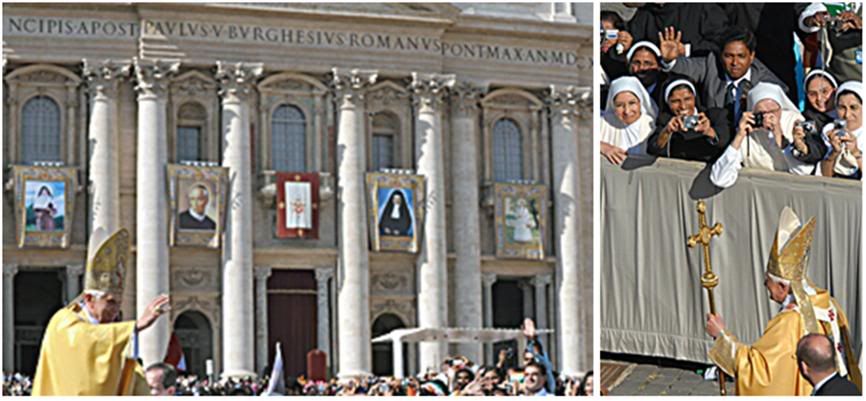
 Above, photos of the Sunday canonization festivities that accompany the OR items posted online. Other Page 1 stories:
Above, photos of the Sunday canonization festivities that accompany the OR items posted online. Other Page 1 stories:
Chaldean Patriarch Delly denounces new violence against Christians in Mosul; tensions in Congo's Great Lakes region
brought to UN Security Council; the World Bank says world's poor increased by a 100 million more because of the global
financial crisis; the second week of the Bishops' Synodal assembly gets under way; and a story on John XXIII's
pastoral service in Venice and Rome.
TODAY AT THE VATICAN
No scheduled events for the Holy Father today (Tuesday).
It's the 8th working day of the current Synod assembly.
The Press Office released the text of the Pope's telegram of condolence to the Apostolic Nuncio
in Ecuador for the death yesterday of Cardinal Antonio José González Zumárraga, emeritus Archbishop of Quito.
***
The results of an international inquiry on Bible reading in the ecumenical perspective
were presented at a news conference by Cardinal Walter Kasper, President of the Pontifical Council for
Promoting Christian Unity; Mons. Vincenzo Paglia, Bishop of Terni (Italy) and president of the Catholic
Bible federation; Rev. Archibald Miller Milloy, Secretary-General of the United Bible Societies; Prof. Luca
Diotallevi, professor of sociology at Roma-III University, who coordinated the survey undertaken by
GFK-Euriska, on behalf of the Catholic Bible Federation.
Mons. Paglia summarized the survey results in a brief report delivered in Italian.
Before the news conference, an agreement was signed between the Catholic Bible Federation and
the UK-based United Bible Societies to work together in the translation and dissemination of the Bible.
|
 14/10/2008 15:53 14/10/2008 15:53 |
|
| | | OFFLINE | | Post: 15.335 | Registrato il: 28/08/2005
| Utente Gold | |
|
 The 'hands-on' Pope:
The 'hands-on' Pope:
Benedict XVI takes the floor
at the Synod assembly

VATICAN CITY, Oct. 14 (Translated from Apcom) - Pope Benedict XVI, to everyone's surprise, delivered an intervention at the morning session of the current Bishop's Synod assembly today.
Taking off from his book JESUS OF NAZARETH, the Pope spoke on fundamental criteria for biblical exegesis and warned against a secularized and positivist approach to Sacred Scriptures, saying that a secular hermeneutic was replacing the hermeneutic (interpretation) of faith.
For instance, he said, the Resurrection must be seen theologically and not judged historically.
He made many references to Dei Verbum, the dogmatic constitution of Vatican-II on Revelation, pointing out that the story of salvation is a true account that can be studied with historical methods but also required a second level of study where it intersects with faith.
The text of the Pope's intervention has not yet been made available.
At the Synod:
A formal intervention
by the Pope

Pope Benedict XVI made a surprise intervention at the 14th congregation (session) of the current Bishop's Synod general assembly, reading from a prepared text. His intervention lasted eight minutes.
The Pope spoke after the morning break, just before the usual turn for auditors to deliver their interventions, according to don Giorgio Costantino, who gives the session briefings to Italian newsmen. The Pope's intervention was not on the schedule.
[The rest of the item repeats what is contained in the Apcom bulletin.]
Pope of surprises? You bet! Always something new...
It may be the first time a Pope has intervened as a participant in a Synod assembly beyond the customary opening and closing remarks. I do not recall that he intervened formally at the 2005 Synod, although he started off the first 'free discussion' hour, held after the regular sessions of the day, that he had initiated for Synod meetings.
I think the intervention accomplishes many things other than the messages contained in it. It shows the bishops that he, too, is a bishop among them, who shares their pastoral concerns on both the local adn universal levels; and who continues - if anyone needs reminding - to be actively involved not just in the study, contemplation of the Word of God and interpretating it for the faithful, but also in keeping up to date with scholarship on the Bible.
What exciting times for the Church this ageless wonder and blessing from God is making us privileged to live!
Here's John Allen's account:
For the first time,
the Pope speaks
By JOHN L. ALLEN JR.

Rome, Oct. 14, 2008
For anyone with a spare dollar looking to make a wager about the Synod of Bishops, here’s the safest bet in the world, in the wake of this morning’s session: There will be a proposition on the relationship between exegesis and theology among the final recommendations presented to Pope Benedict XVI.
Truth to be told, the relationship between Biblical interpretation and other areas of Catholic theology had already emerged as a major concern.
This morning, however, Pope Benedict himself took the unusual – indeed, quite possibly unprecedented – step of explicitly recommending that the bishops adopt a proposition on how exegetes and theologians can better inform each other’s work.
The recommendation was delivered viva voce, as Benedict XVI took the microphone at the synod for the first time. He spoke immediately after the customary 10:30 am coffee break; Archbishop Nikola Eterovich, secretary of the synod, informed the group that they would have to interrupt their normal program “because our president wishes to address us.”
Technically, the Pope is also president of the Synod of Bishops.
The Vatican is expected to release a transcript of the Pope’s remarks either later today or tomorrow.
For now, the official Vatican bulletin has simply reported that "Starting from the consideration of the work for his book Jesus of Nazareth, the Holy Father dwelt upon the fundamental criteria of Biblical exegesis, upon the dangers of a secularized and positivistic approach to the Sacred Scriptures and upon the need for a closer relationship between exegesis and theology."
Synod sources said that he spoke for a little less than ten minutes, drawing upon notes that he had apparently made in a small notebook.
In broad terms, those sources said, his topic was the need for historical-critical interpretation of the Bible to take Christian faith as its point of departure, because otherwise its risks treating the Bible as simply a “book of the past.”
In that regard, the Pope apparently suggested that exegesis needs to be better integrated into theology, so that it is seen less as a self-standing enterprise, and more as part of a broad effort to combine reason and faith.
As part of his reflection, Benedict reportedly suggested to the bishops that a proposition on the relationship between exegesis and theology would be helpful – making it all but a foregone conclusion that at least one such proposition will be offered.
Since the propositions are addressed to the Pope in any event, as suggestions for whatever document he may eventually issue on the topic of the synod, it’s also a safe bet that Benedict XVI will discuss the need to treat scripture as “the soul of theology” in that text.
Sources said that the Pope was greeted by a hearty round of applause at the close of his remarks.
This is the second Synod of Bishops under Benedict XVI, and the second time the Pope has chosen to address the bishops towards the end of the initial round of speech-making, as the agenda for the synod’s final documents is beginning to take shape.
In each case, Benedict has reflected briefly on what had emerged as a central concern during those opening speeches. During the Synod on the Eucharist in 2005, Benedict spoke about the relationship between the horizontal and vertical dimensions of the Mass, meaning the twin images of the Mass as a meal and as a sacrifice – suggesting they need to held together rather than put in tension. [Thanks for setting me straight on this.]
The Pope appears to have struck a similar note this time around about the relationship between exegesis and theology – suggesting that offering both/and solutions to seemingly either/or problems may be emerging as what one might call the "synodal specialty" of Benedict XVI.
Benedict has been present for most of the synod’s deliberations thus far, including the hour set aside for “free discussion” at the end of each day. That hour was set aside at Benedict’s request for the 2005 synod, and has now become a part of the event’s formal structure.
Fr. Bryan Massingale of Marquette University, President-elect of the Catholic Theological Society of America, acknowledged that sometimes exegetes and theologians struggle to stay on the same page -- not, for the most part, because of ill will or intellectual disagreements, but rather the compartmentalized nature of the academy these days.
"As theology becomes more and more specialized, we need to create opportunities in which theologians and exegetes can pursue collaborative projects," Massingale said in a telephone interview this afternoon.
Massingale said one such initiative is already underway at Marquette: a new inter-disciplinary seminar titled "Theological Interpretation of Scripture."
"We may still run into disagreements over what constitutes theological interpretation of the Bible," Massingale said, "but at least there's the beginnings of a conversation."
Orthodox selegate sees Pope's mission
as the duty to promote Christian unity

VATICAN CITY, OCT. 12, 2008 (Zenit.org).- A representative of the Orthodox Church who addressed the world Synod of Bishops spoke of the Bishop of Rome as a sign of unity among Christians.
Archimandrite Ignatios Sotiriadis, fraternal delegate from the Orthodox Church of Greece, spoke Saturday to the synod, which is focusing on the Word of God in the life and mission of the Church.
His address brought more applause than any other intervention in the first week of the synod.
"Your Holiness," he said, "our society is tired and sick. It seeks but does not find! It drinks but its thirst is not quenched. Our society demands of us Christians -- Catholics, Orthodox, Protestants, Anglicans -- a common witness, a unified voice. Here lies our responsibility as pastors of the Churches in the 21st Century."
"Here," the Orthodox pastor continued, "is the primary mission of the First Bishop of Christianity, of him who presides in charity, and, above all, of a Pope who is Magister Theologiae: to be the visible and paternal sign of unity, and to lead under the guidance of the Holy Spirit and according to Sacred Tradition, with wisdom, humility and dynamism, together with all the bishops of the world, fellow successors of the apostles, all humanity to Christ the redeemer."
"This is the profound desire of those who have the painful longing in their heart for the undivided Church, 'Una, Sancta, Catholica et Apostolica,'" he concluded. "But it is also the desire of those who, again today, in a world without Christ, fervently, but also with filial trust and faith, repeat the words of the apostles: 'Lord, to whom shall we go? You have the words of eternal life!'"
**********
It is surprising that John Allen, in reporting on Archimandrite Ignatios's intervention - see post today, Oct. 14, in NEWS ABOUT THE CHURCH on Allen's Synod reports -
freeforumzone.leonardo.it/discussione.aspx?idd=354498&p=109&#idm...
missed this part about the Pope completely, and/or chose instead to report Ignatios's reproach that the Church needs to examine its conscience about 'the historical failures of Christianity'.
Of course, one can appreciate that Allen has a monumental daily task: to report on the assembly proper without being in the hall itself - on the basis of briefings from the English-language briefer, the texts of the delivered interventions which are later given out to newsmen [most of which he has to read in Italian and then translate the excerpts he uses], and his own enterprising interviews with some of the participants.
But he manages to provide a virtual one-man news service that is generally more focused, comprehensive and consistent about any event he covers than what is available elsewhere in the Anglophone media. I hope NCR pays him enough for his labots.
[Modificato da TERESA BENEDETTA 14/10/2008 20:10] |
 15/10/2008 02:30 15/10/2008 02:30 |
|
| | | OFFLINE | | Post: 15.340 | Registrato il: 28/08/2005
| Utente Gold | |
|
 The fact that the Holy Father intervened at the Synod assembly Tuesday morning made the deadline for tomorrow's OR, but not its complete text. Here's the OR report which, notably, uses no quotation marks, reporting everything as indirect quotations.:
The fact that the Holy Father intervened at the Synod assembly Tuesday morning made the deadline for tomorrow's OR, but not its complete text. Here's the OR report which, notably, uses no quotation marks, reporting everything as indirect quotations.:
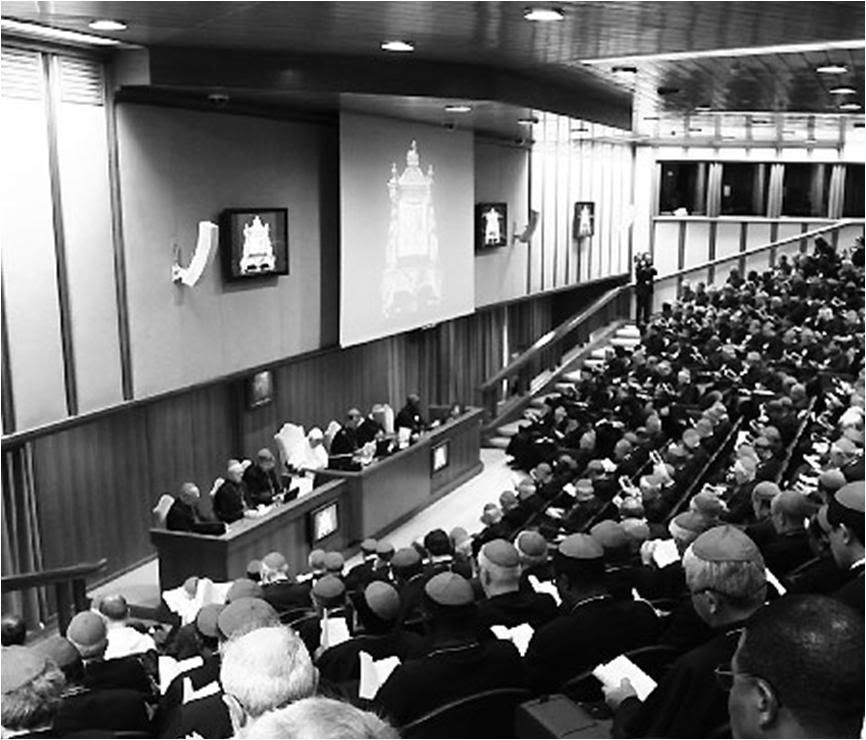 Avvenire's photo from the Synod today.
Benedict XVI's intervention
Avvenire's photo from the Synod today.
Benedict XVI's intervention
at the synod assembly:
A complete method for reading
and understanding the Bible
Translated from
the 10/15/08 issue of

To better understand the Bible even from the viewpoint of faith, exegetes with a complete formation are needed. The historico-critical method is positive, but it needs completion, the Holy Father said yesterday morning in an intervention at the 14th general congregation of the current Bishops' Synod assembly.
Essentially, his intervention referred back to the document on the interpretation of the Bible in the Church, which was published by the Pontifical Biblical Commission in 1193, under the presidency of Cardinal Joseph Ratzinger, who was then the Prefect of the Congregation for the Doctrine of the Faith.
Beware of the risks of Biblical interpretation that is exclusively historico-critical, the Pope said, speaking after the morning break, almost echoing that important document.
We have heard everything good that one can possibly get from (that kind of) exegesis, he continued, but we should also consider its risks. The historico-critical method helps to understand that sacred text is not mythology but true history, (so) it helps to grasp the profound unity of all Scripture.
Contributions that are often of the highest academic quality can help to perceive all the reality of a historic fact, but it can also lead us to think that the Bible is a book that is only about the past.
Benedict XVI then referred to the second point in Dei Verbum: If the hermeneutic of faith disappears, he said, then what replaces it is positivist or secularist hermeneutic according to which the divine does not appear in history.
And everything is reduced to the human, as it is today in the mainstream of Biblical exegesis in Germany, which negates the resurrection of Christ and the founding of the Eucharist by the Son of God.
According to the Pope, there is no reason for the dualism which now separates theology and exegesis: A theology that is not based on the interpretation of Scripture is a theology without foundation, just as as exegesis that is not theological has no foundation.
In practical terms, Benedict XVI concluded, the formation of future exegetes must be broadened.
The morning session included earlier the intervention of the Cardinal Secretary of State Tarcisio Bertone, who spoke about pastoral care of young people. [As a Don Bosco Salesian, Cardinal Bertone has a broad background of ministering to young people.]
Taken by itself, he said, the Bible does not usually inspire particular attraction and affection in the eyes of a young person. [Presumably citing a survey], he said that among those aged 14-19, only 13% believe that "one must meditate on sacred texts if one believes in God".
But, he said, if the Bible is introduced through educators and credible witnesses, then young people show surprising openness toward the Bible.
Earlier, Cardinal Delly, Patriarch of Babylon of the Chaldeans, spoke of the present situation of the Church in Iraq which is 'submerged in too much sorrow'.
I must say that the OR has not proven to be much use as a record of the Synod, at least for what it posts online - reports limited to brief accounts like the above, which are too sketchy to give a sense of the wide range of topics brought up at the bishops' assembly.
It is possible that they run the excerpts from major interventions posted daily for each session by Vatican Information Services, which, along with ZENIT, has been providing this service.
But here's an interesting idea:
Pope Benedict as Bible blogger?
by John Thavis

October 14, 2008
VATICAN CITY — The Synod of Bishops on the Bible heard an unusual suggestion Tuesday morning when a Hong Kong observer asked Pope Benedict to start up his own daily blog on Scripture.
Agnes Kam Leng Lam, president of the Catholic Biblical Association of Hong Kong, said people need to experience Scripture in small but significant doses.
“To put it in a nutshell, I’d like to suggest to you, Holy Father, to start a multi-language blog to shepherd today’s world by scriptural verses, daily verses,” she said on the synod floor.
The Pope’s blog should include simple reflections that relate Scripture to real-life situations, she said.
Lam included advice that’s probably good for any blogger: “Brief texts, Holy Father, and plentiful images - and this will be very attractive to the young generation and to today’s people.”
The talk apparently provoked a positive reaction and some laughter, but the Pope, who was presiding over the Oct. 5-26 assembly, didn’t say whether he’d be blogging anytime soon.
Why not, actually? It may sound like piling on additional 'duties' for him, but it probably could get started by recycling material he has written and said over the decades. I'm sure that internally, within the Schulerkreis or as part of Birgit Wansing's bibliographical duties, there already exists a concordance of Ratzinger-B16's complete works (that is updated daily to include what he says and writes as Pope) that would lead instantly to any reference necessary.
With some efficient help, the daily 'blogs' could be prepared ahead of time - say, a month's material in advance - based on a theme that the Pope suggests, or simply picking up from the Gospel of the day, and appropriately illustrated.
Or, if the Holy Father 'buys' the idea, he could well dictate a daily brief commentary on a Biblical text in language that is accessible to everyone, as he knows very well to do.
I've always wondered whether he gives a homily every day during the private Mass that he starts the day with, because however brief that may be, it could just as well be the material for the 'blog'... I may be dreaming, but in the Internet age, how much 'cooler' that would be than SMS and XT3 messages! The Pastor of the Universa Church directly exercising a pastoral service daily on a global basis... I'm getting carried away....
[Modificato da TERESA BENEDETTA 15/10/2008 18:34] |
 15/10/2008 04:45 15/10/2008 04:45 |
|
| | | OFFLINE | Post: 3.355 | Registrato il: 23/11/2005
| Utente Master | |
|
Here's another account of the pope's comments at the synod today. This one gets more personal about Papa.
Showing Us What It Means to “Open the Scriptures"
By Father Thomas Rosica, CSB
VATICAN CITY, OCT. 14, 2008 (Zenit.org).-The big news today was Pope Benedict's lesson at this morning's session of the synod of bishops.
After listening to the first round of 11 cardinals and bishops deliver their five-minute talks, we heard the solemn pronouncement "Fiat intervallum." (Let there be a break!), which we have heard many times over the past 10 days.
While many of us are used to hearing "Fiat lux" from the Genesis account of creation, or responding with "Fiat mihi senundum verbum tuum" (Be it done to me according to your word) during the Angelus, the words "Fiat intervallum" signal those long desired and merited espresso or caffé latte breaks from the hours of sitting and listening in the "Aula del Sinodo." (When I return to Toronto at the end of the synod, I will begin using "Fiat intervallum" at Salt and Light Television, rather than the crude "breaktime.")
Benedict at the table in the aula
Immediately following the "intervallum," we returned to the synod hall and were informed by Archbishop Eterovic that the "president" of the synod would now like to address us. And the president is the Holy Father! Pope Benedict sat down in his usual spot, put on the professorial glasses, opened his notebook and began speaking to the synodal assembly.
Every single person in the room came to life and paid close attention, including the synod staff, secretaries, "runners" and of course the five language press attaches. We were not given any "script" for this lesson and realized that the Pope was simply reading his own handwriting out of a notebook. Here before a sampling of the world Church was Joseph Ratzinger the professor, sitting among his students, disciples and colleagues, sharing his reflections on what he has seen and heard during the first week of the synod of bishops.
Referring to "Dei Verbum," the Dogmatic Constitution on Divine Revelation, the Pope spoke of the importance of the historical-critical method that finds its roots in John 1:14, the Word becoming flesh. The Pope spoke to us as a father and teacher, reminding the assembly of the importance of Scripture studies that reflect the unity of all Scriptures; studies that are done with and flow from the living tradition of the Church. Our exegesis and analysis of the word of God must always have a theological dimension for we are not simply dealing with a history book of the past but with a Word that is alive in the community of the Church: a Word that is Jesus. When biblical exegesis is divorced from the living, breathing community of faith that is in the Church, exegesis is reduced to historiography and nothing more. The hermeneutic of faith disappears. We reduce everything to human sources and can simply explain everything away. Ultimately, we deny the One about whom the Scriptures speak, the one whose living presence lies underneath the words. When exegesis is divorced from theology, then Scripture will not be the soul of theology. The Pope stressed the intrinsic link between Scripture studies and the theological tradition of the Church. He also stressed the importance of theology that is rooted in the Bible.
In his simple, crystal clear address, Pope Benedict touched upon one of the important themes that has emerged in spades during this synod: bridging the gap that exists between those who have distorted the study and interpretation of the word of God and separated their Scripture studies and biblical analyses from theology and the living community of the Church. The Pope also made a strong suggestion that certain matters touched upon in his "lesson" be included among the propositions that will be given to him by the synodal assembly next week.
O ne of Pope Benedict's great qualities is his ability to teach very complex things with simplicity, clarity and beauty. This morning, Benedict was a teacher who unfolded for us the scroll of the living Word of God and showed us how to humbly approach that Word, learn from it and live by it. We received a simple, clear lesson about the unity of Scripture and theology from a man who is often called the "Mozart of theologians."
A young Italian layman working in the Vatican told me this week in passing: "Papa Ratzinger makes you want to love Jesus and the Church even if you have been far away from the Lord and the Church for a long time. He is a kind man."
[Modificato da benefan 15/10/2008 04:46] |
 15/10/2008 17:09 15/10/2008 17:09 |
|
| | | OFFLINE | | Post: 15.341 | Registrato il: 28/08/2005
| Utente Gold | |
|

OR today.
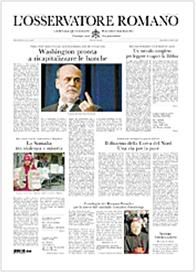  The main headline is about Washington's readiness to recapitalize
The main headline is about Washington's readiness to recapitalize
some failing banks (main Page 1 photo is US Federal Reserve
chairman Ben Bernanke). The two papal stories on Page 1 are -
Benedict XVI's intervention at the Bishops' Synod:
'A complete method to read and understand the Bible'
[Translation of this was posted last night, two posts above]
and the Holy Father's condolences on the death of
Cardinal Gonzalez Zumarraga, emeritus Archbishop
of Quito (Ecuador)(in photo).
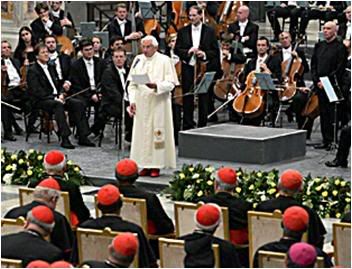
Surprisingly, the OR has no picture of the Pope at yesterday's Synod
session, but its online service features a photo from the Monday
evening concert for the Pope, which accompanies the text of the
remarks he gave afterwards. Other Page 1 stories: North Korea's
nuclear disarmament; and Somalia caught up in violence and poverty.
THE POPE'S DAY
General Audience today.
The Holy Father spoke of St. Paul's ideas about the Church.
Working Day #9 of the Synodal assembly.
Presumably, the Pope is attending, as he has been
at most of the general sessions so far.
[Modificato da TERESA BENEDETTA 15/10/2008 20:33] |
 15/10/2008 17:40 15/10/2008 17:40 |
|
| | | OFFLINE | | Post: 15.342 | Registrato il: 28/08/2005
| Utente Gold | |
|
 GENERAL AUDIENCE TODAY
A full translation of the Holy Fahter's catechesis today has been posted in
GENERAL AUDIENCE TODAY
A full translation of the Holy Fahter's catechesis today has been posted in AUDIENCE & ANGELUS TEXTS.
Continuing his Pauline Year catechetical cycle, the Holy Father today spoke of St. Paul's thinking about the Church.
In his greetings after the catechesis, Benedict XVI also recalled the 30th anniversary of John Paul II's election as Pope on Oct. 16, 1978, and the feast day today of St. Teresa of Avila.
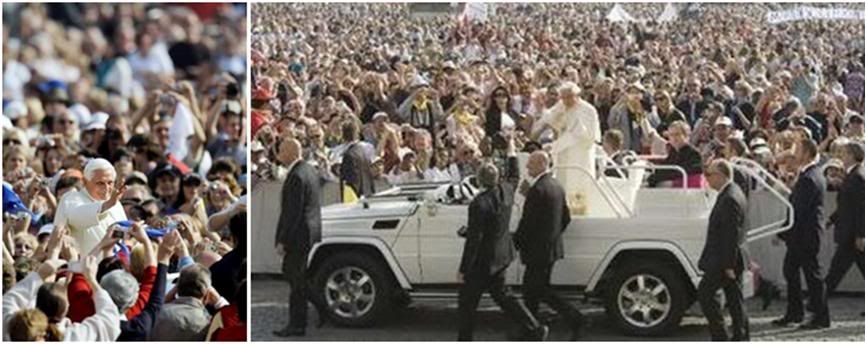

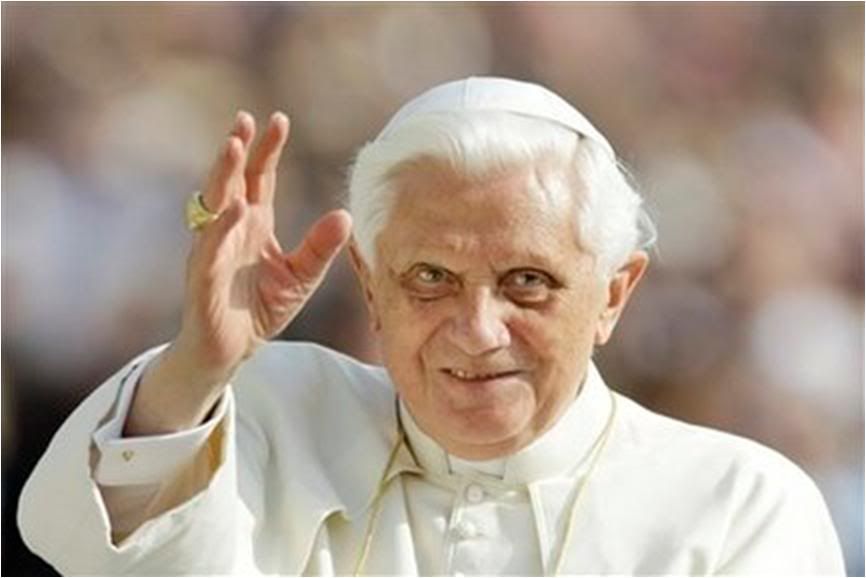
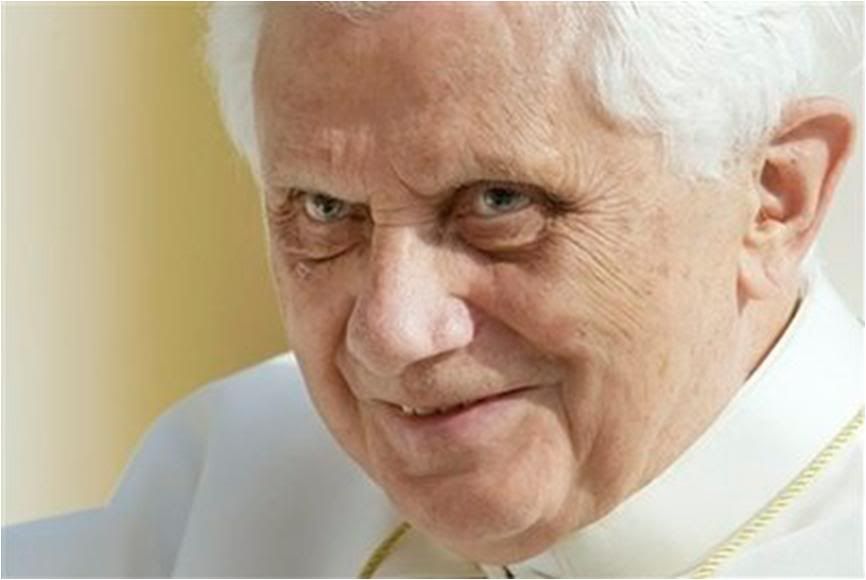
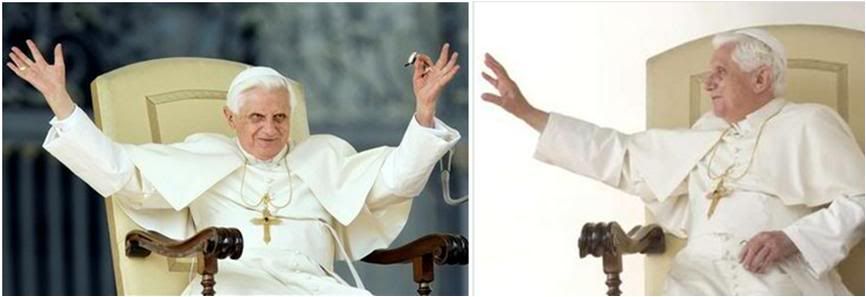 Here is what he said in English to sum up today's lesson:
Here is what he said in English to sum up today's lesson:
In our continuing catechesis on Saint Paul, we now consider his teaching on the Church.
It was "the Church of God" which Paul persecuted before his conversion, and throughout his Letters he uses the term "Church" both with reference to local Christian communities and to the Church as a whole.
For Paul, faith in the person of Jesus Christ and his Gospel is at the heart of the Church. Paul’s entire work of evangelization, centred on the proclamation of the Paschal mystery of the Lord’s death and resurrection, was aimed at establishing new communities of those who believe in the Lord and share in the life of the Spirit.
The Church thus takes shape as an "ekklesía", a concrete assembly called into being by God’s word. For Paul, the Church is also the "Body of Christ", a living body endowed with a complex of ministries which are spiritual in their origin and purpose.
In the variety and the theological richness of his teaching on the Church, Paul invites us to understand and love the Church ever more deeply, and to work for her upbuilding in faith and charity.
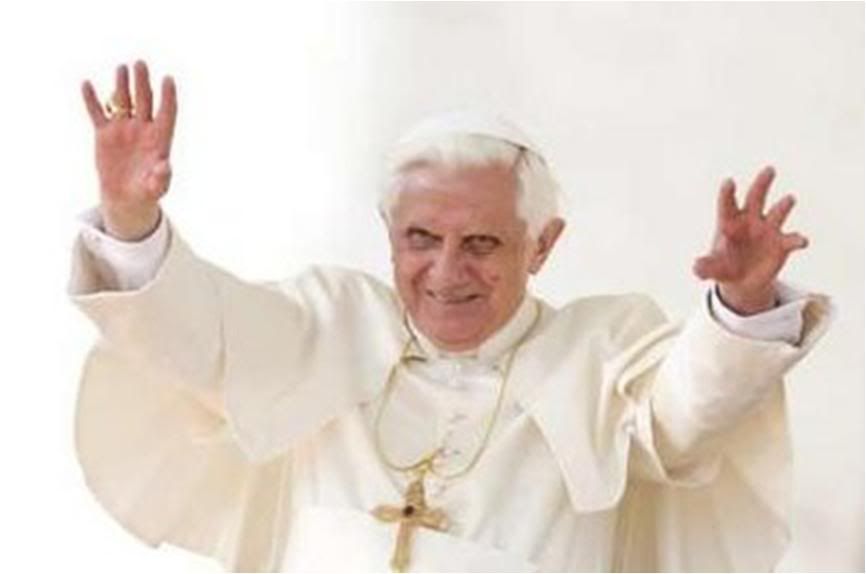
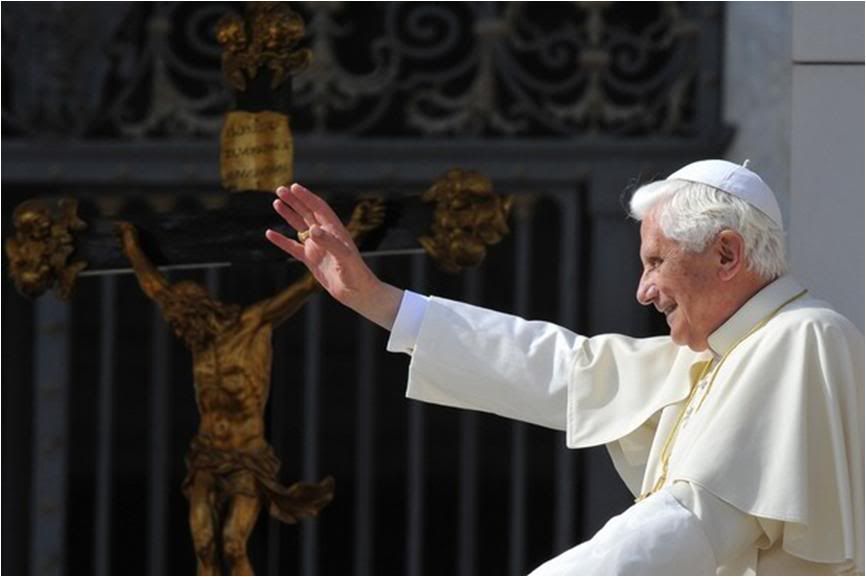
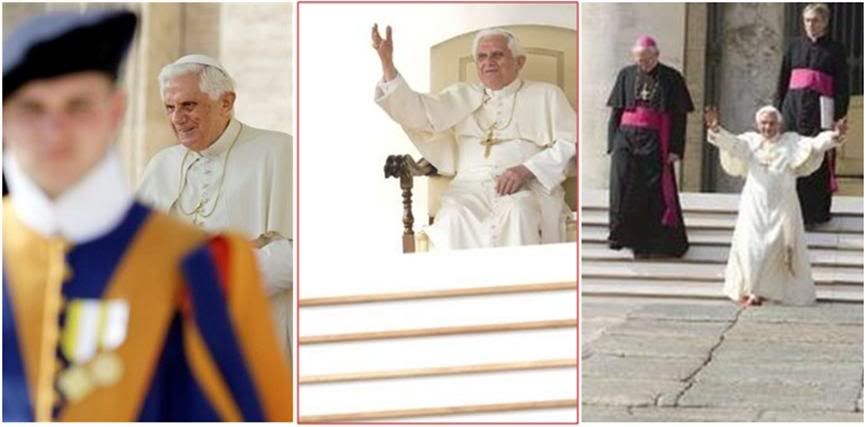
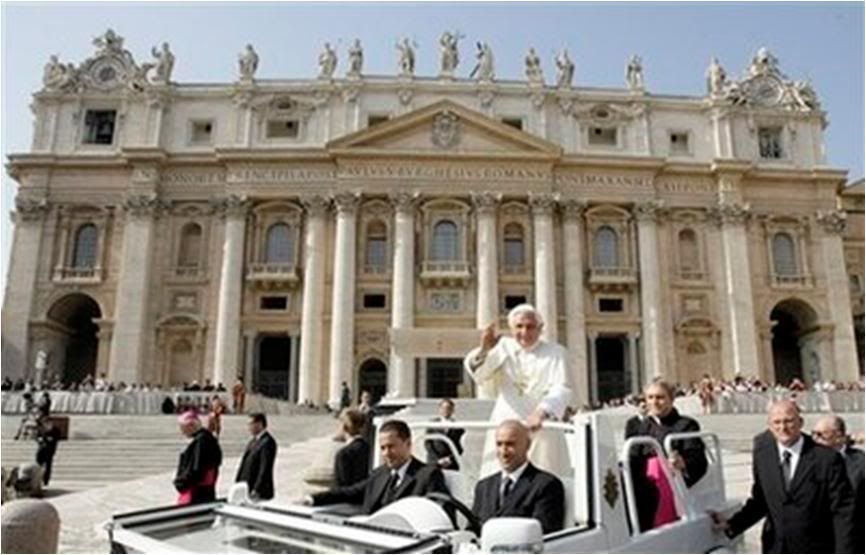
[Modificato da TERESA BENEDETTA 16/10/2008 06:55] |
|
|
|
|